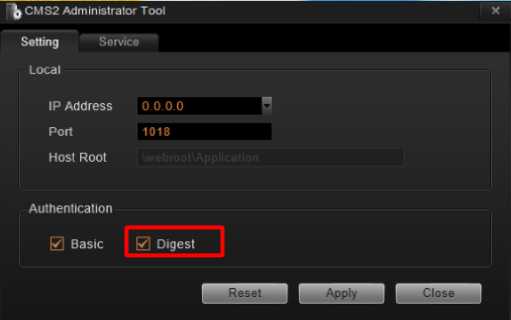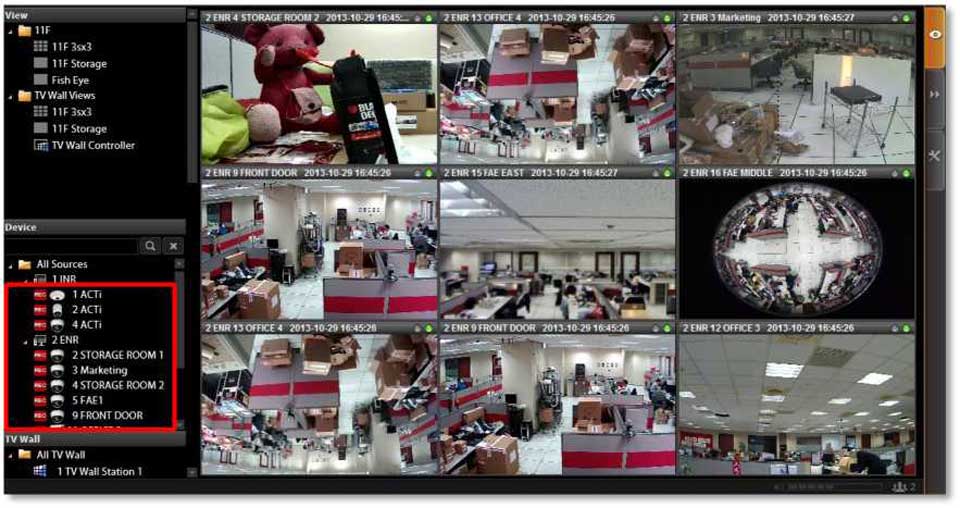ACTi CMS 2.0 Installation Guide Access and control all NVR servers and cameras, even if they are on the other side of the world.
Powerful tools to centrally manage NVRs and cameras in multiple locations – no matter if on different floors or different continents.
Connecting Vision
1| LOGIN & LOGOUT
BEFORE YOU START
Thank you for using ACTi CMS 2.0 server system. This guide will demonstrate the fundamentals of how to:
You may download ACTi CMS 2.0 User’s Manual for detailed operation instructions from product page: http://www.acti.com/CMS2
For technical support, please contact your system supplier or contact our technical support team via http://www.acti.com/chd.
ACTi CMS 2.0 Installation Guide
Read More :
Log in via CMS2 Workstation
(The Password field is case-sensitive)
İ2İ OVERVIEW
Click the buttons on the right to switch between two main screens:
Live View
- Search / Play back recordings
- Export snapshots or video
Log out from CMS On top of the screen,
Logout
3İ LIVE VIEW
You will enter the default live view layout after logging
in.
Left-click on a view
□2
‘Channel
Event
•Watch all cameras ■ of an NVR site :
Click on the NVR
•Watch a camera: Drag it into layout
–
Q
|| All Sources
I j îğj 1 MobileGo |
1 11 F_Entrance B© 2 11F_Lab B © 3 7F_Office Area A rec IS 4 7F Office PTZ
5 7F Office Area B =T 6 7F Office Area All B© 7 7F Entrance e®[8 7F_Entrance_Coi rec Q 11F Entrance OiJ
Device
View
• Watch an instant event playback: Select the desired NVR source, and double-click on the event.
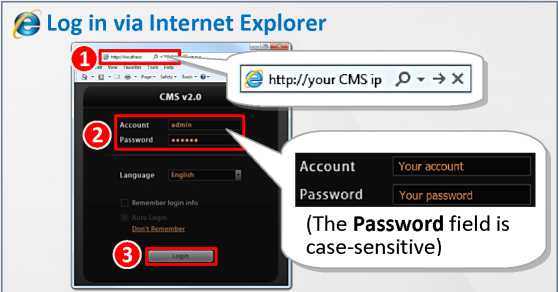
![]()
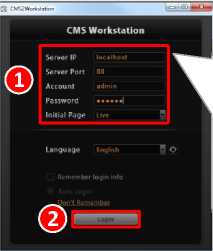
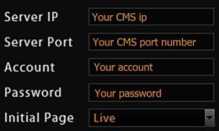

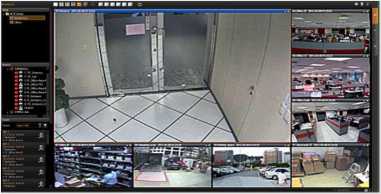
![]()
![]()
![]()
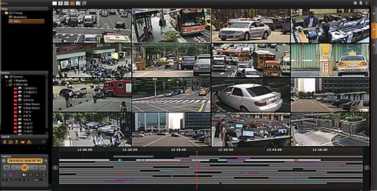
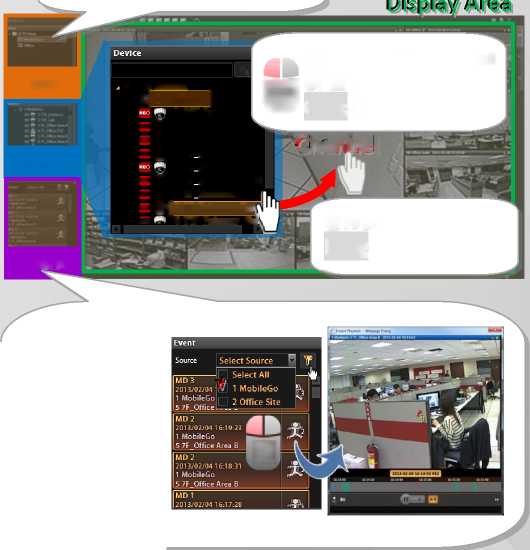
Connecting Vision
4 SINGLE CHANNEL OPTIONS
5 PTZ OPERATION
Operate digital PTZ function
Use the mouse to do digital PTZ operation on a selected
On Live View screen, select a single channel on layout.
Take a snapshot to client PC Start/Stop manual recording
Show live view windows on a map
• Show single camera live view: Double-click on the camera icon
• Link to another map: Click
Right-click to open channel menu^ “Show All Live View’
Hold left button and draw.
Hold left-button and move the red frame.
Right-click in PiP window.
Operate optical PTZ function
Operate a PTZ camera with on-screen controls/joystick.
Preset/Tour /Command menu
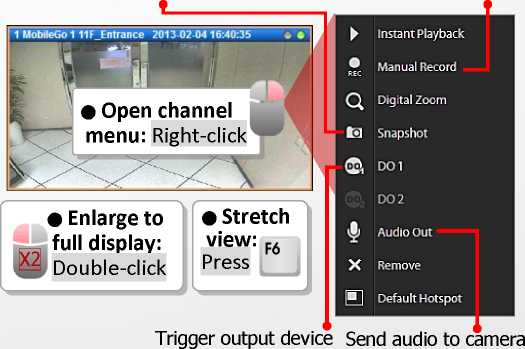
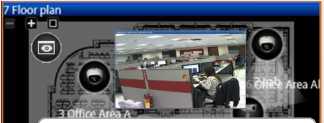
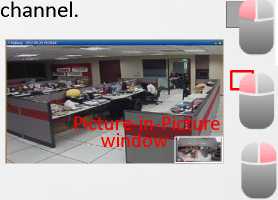
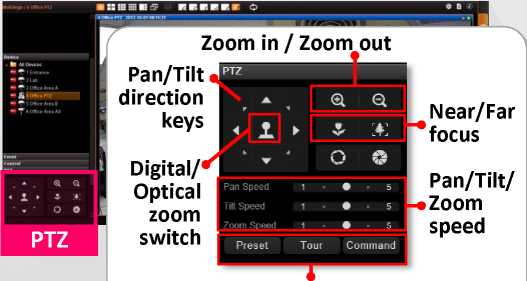
7İ EXPORT VIDEO
Msearch PLAYBACK
- Enter Playback screen, select a View or drag a camera to Display area.
- İDrag the Time Bar to find specific scene, and use the controls on Control panel to play and search.
•Apply a preset view
View
Device
a
camera: Drag it into layout
•Watch all I cameras of an
NVR site :Click on
the NVR
Time Bai
- Enter Playback screen, drag the Time Bar to video start point, right-click and select “Mark Export Start” on quick menu.
- Drag to video end point, right-click and select “Mark Export End” on quick menu.
- Right-click and select “Export Video”.
Control
Rewind /Pause /Play Go to specific time
Previous •Display*, event
Go to current time
Next Search Export video
• *
Play speed Time bar scale
4. Set the export settings, and then click “Apply”.
NOTE: The exported video and snapshots are saved to your designated file location, the default location is Windows desktop.
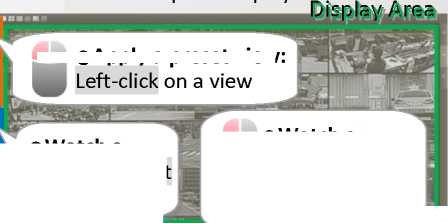

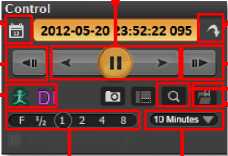
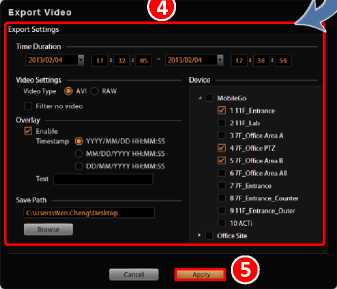
INSTALL THE SERVER
Step 1
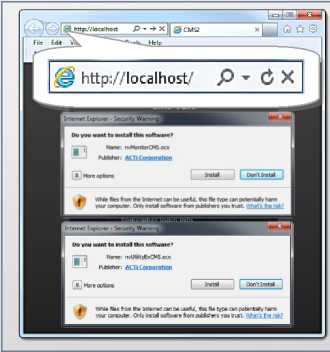
ACCESS VIA BROWSER
Step 2
Quick Installation Guide
BEFORE YOU START
Thank you for using ACTi CMS 2.0 product. This guide will demonstrate the fundamentals of how to setup ACTi CMS 2.0 system. For detailed instructions, please refer to ACTi CMS 2.0 System Administrator’s Manual from http://www.acti.com/downloadcenter
Pre-requisites before installation:
- Ensure that your CMS server computer meets the minimum system requirements.
- Uninstall other ACTi NVR or previous CMS server product on the CMS server computer, and manually delete ACTi Corporation program folder.
- Disable UAC function in Windows.
- Make sure your NVR servers have been upgraded to the latest version.
Customer Help Desk: http://www.acti.com/CHD US/Canada Toll-free Helpline: 1-866-410-2284 (ACTi)
| ACTi CMS Server v2A01 – InstallShield Wizard
ACTi Connecting Vision |
Execute install shield
ACTi_CMS_Server_ v2.0.10.exe. |
| Welcome to the InstallShield Wizard for ACTi CMS Server v2.0.01
The InstalSfeeM Wizard veil nstal ACTi CMS Server v2.0.01 on you computer. To continue, click Next |
Follow onscreen instructions to complete the installation. |
| Back | Next > | |_. Cancel | |
Wait for a few seconds until the server is ready.
Connect to http://localhost/ via
Internet Explorer.
Install two ACTi ActiveX control components.
Step 3
LOGIN
CMS v2.0
Account admin
Password ••••••
On Login page, enter: •Account: admin • Password: 123456
Click “Login”.
Live View
Playback
Setup
Language English
Remember login info
Don’t Remember
Note
If you meet any of the following problems, please try the methods below to fix it or contact our technical support team:
- Cannot access Login page
- Server is not ready, please wait for a while and connect again.
- Your CMS server port is being used by another application, please close that application. For instance, if you use default port 80, Skype might have taken it.
- Cannot install the ActiveX controls
- Use Internet Explorer browser 32-bit version.
- The UAC function in Windows Vista or Windows 7 restricts the installation of add-ons. Please turn off the UAC function.
- Internet Explorer security settings restrict the installation of add-on components. Please turn off the browser’s ActiveX Filtering function, add this CMS server site to Trusted sites list, and set the security level to Medium-high or lower.
REGISTER THE LICENSE
Step 4
1′ Make sure you have the information on hand:
License key and ACTi member account/password
(ACTi Member Center – http://member.acti.com/)
■Go to Setup page ^ System tab ^ License
3′ On Online Registration tab, fill in the required fields, and then click “Apply”. Make sure the total of licensed channels is enough for the number of devices you are going to add to CMS server.
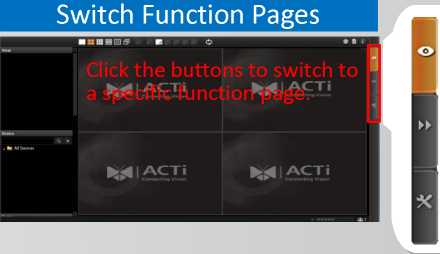
![]()

Connecting Vision
CREATE USERS
Step 5
ADD NVR SERVERS
Step 6

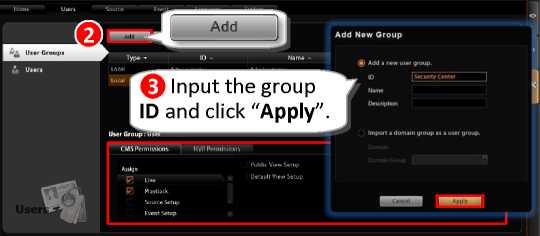
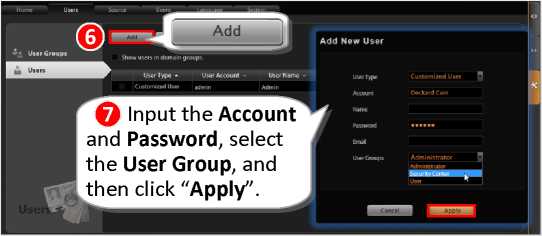
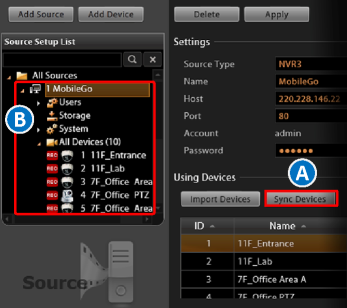
(fl Enter Setup page ^ Users tab ^ ,■
Add a user group:
expand its properties.
■Select the newly-created group on the group list and modify its CMS Permissions and NVR Permissions.
■On Users tab, select | Users
Create a new user account:
(fl Enter Setup page ^ Source tab, and click “Add Source”.

(fl Input the NVR server information and the NVR Administrator’s password, and then click “Apply”.
![]()
On All Sources tree, click □ by the NVR sever name to
(A) To synchronize with the devices, click i (B) To modify NVR server or device settings, click the item in the NVR category to enter setup page.
SET EVENT RULES
Step 7
CUSTOMIZE LIVE VIEWS
Step 8
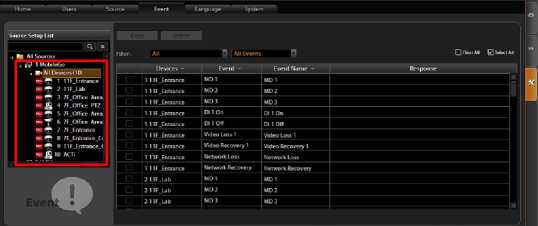
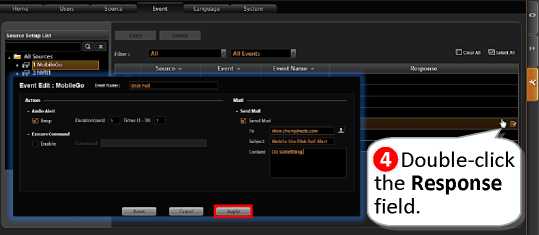
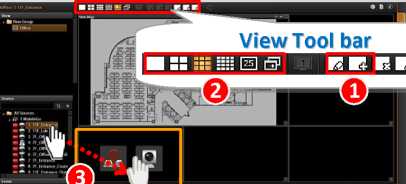
O Select an event type from the event list.
(■Configure the response settings on Event Edit window, and then click “Apply”.
VALIDATION
Step 9
fl Enter Setup page ^ Event tab
fl From All Sources t ree, select your event source: an NVR server or a device – .
- Go to Live View page. On View Tool bar, click O to create a new view, then clickQ to enter edit mode.
- Select a layout style.
- »To add a camera view: Pull a device from Device list to a channel.
•To add a map view: Select a channel and click I , upload the map, drag the lower right corners to adjust map size, and add devices from Device list.
- On View Tool bar, click ! to save the view.
- ClickO to set this view as default live view.
- On Live View page, check live streaming by selecting a view on View list or an NVR in Device list.
- On Live View page, check the Event list for instant event notifications from devices.
- On Playback page, check the recordings by selecting a view on View list or an NVR in Device list, drag the time bar and use the Control buttons to play.
Connecting Vision
Designed for large-scale multi-site video surveillance solution, Central Management System 2.0 (hereafter referred to as CMS) software allows its user the full capabilities to monitor and manage multiple Network Video Recorders (NVR) via network. It also possesses full functionalities to manage not only NVRs but devices (network cameras, video encoders, etc.), users and events.
CMS Server / Client Architecture
CMS is a typical web-based server/client system. In a multi-site surveillance solution, CMS Server serves as a management command center; a Client makes requests of monitoring video streams or playing recordings sent to CMS Server, and CMS Server will pass this request to the involved NVR Server to send data/video stream to the Client. CMS Server starts automatically as soon as the Server computer (where it is installed) boots up, and operates in the background without requiring the login of administrator. It would provide services over the TCP/IP network to multiple Clients upon requests coming through HTTP protocol.
There are two types of Clients in CMS system: Web Client and Workstation Client. A user, connecting from whether web browser or workstation, will be provided with the same user interface and be CMS functions.
- Web Client: the web version of interface to access CMS Server without the need of installing any client program. Logging in to the CMS Server is as simple as visiting a website through the browser.
- Workstation Client: the client application making accessing CMS Server free from the use of browser .The workstation includes a set of programs that provide interface between users and the CMS Server.

Please preview these prerequisites below and make sure they are met before installation:
Please upgrade all the NVR servers to the latest version.
Ensure that the server computer meets the minimum system requirements.
As the previous ACTi NVR server software ( NVR 2.X) or previous CMS server software (CMS1.X) cannot co-exist with CMS 2.0 server on the same computer, please uninstall their main program and patches from Windows ^ Control Panel before installing CMS 2.0 server. Please also manually delete the program folder. By default, this folder ACTi Corporation is under C:\Program Files.
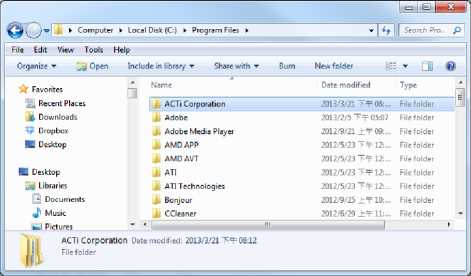
UAC (User Access Control) is a security setting that restricts access in Microsoft Windows.
You must disable UAC before installing CMS 2.0 in Windows 7, for the installation of application components and certain program features would be interrupted by this security rule. If you are using Windows 8, please enable the built-in Administrator account and log in with this identity, or add this CMS site to IE browser’s trusted sites (please follow the solution provided for Condition 2: Why can’t I install Active X controls after logging in? on page 29 to do so).
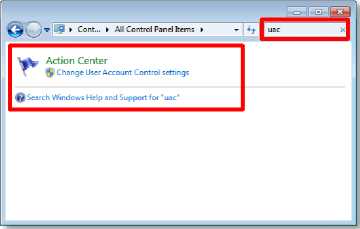
the computer for this change to take place.
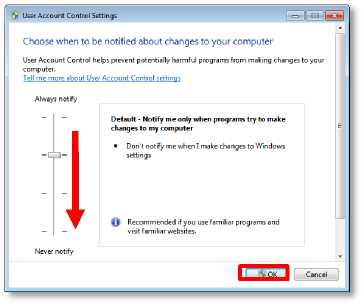
1.
Go to Windows Control Panel, click “User Account and Family safety”.
System and Maintenance Get started with Windows
Back up your computer
Security
«jPw Check for updates
Check this computer’s security status
»
Allow a programı through Windows Firewall
Network and Internet View network status and tasks Set up file sharing
^■7 Hardware and Sound
Play CDs or other media automatically
Mouse
Programs
■-tt|| Uninstall a program
Change startup programs
User Accounts and Family Safety
SŞ Set up parental controls for any user ®Add or remove user accounts
m . Appearance and Personalization Change desktop background Change the color scheme Adjust screen resolution
jLjh Clock, Language, and Region j” Change keyboards or other input
methods
Ease of Access Let Windows suggest settings Optimize visual display
I y I Additional Options
Select the account, then “Turn User Account Control on or off”.
2.
secure” window, uncheck the “Use User Account Control (UAC) to help protect
your computer“. Click on the “OK” to apply, you will have to restart the computer for this change to take place.
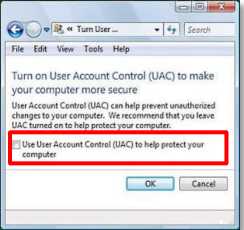
The server program installation is as easy as 1-2-3 by following the installation wizard’s instructions. The server would start its service right after installation completes, without the need to restart the server computer.
Install the Software
- Execute the install shield application .
- Follow the onscreen instructions of InstallShield Wizard, accept the license agreement and proceed.
A<=Ti
Connecting Vision
License Agreement
Please read the following license agreement carefully.
Important Notice A
Please read the terms and conditions of this license agreement carefully before installing the software. This end user license agreement (EULA) is between you (either an individual, or a single legal entity) and ACTi. By installing the software and clicking on the “agree” button, you agree to the term and conditions of this agreement. If you do not agree to this v
^^^TccepUh^erm^Uh^icens^gr^^^^^] | Print
O I do not accept the terms of the license agreement
InstallShield I
< Back Cancel |
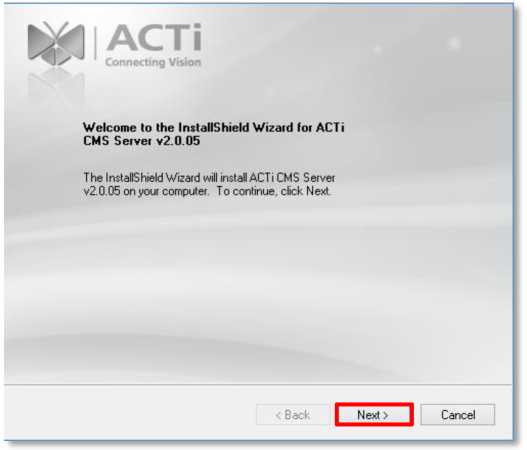
When selecting Setup Type, the default “Complete” will have the program installed on default C drive, you may select “Custom” to choose another program location.
MI ACTi
Connecting Vision
Setup Type
Select the setup type to install.
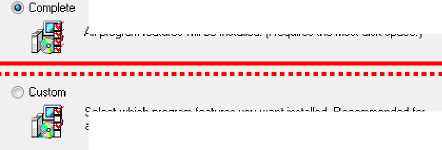
Please select a setup type.
All program features will be installed. (Requires the most disk space.)
Select which program features you want installed. Recommended for advanced users.
I nstallShield
J < Back Cancel |
The IP Port Checker will pop up to confirm the CMS port number. The installation program will use 80 as default. You may enter another available port number in “Listen Port” field and click “Apply”.
3.
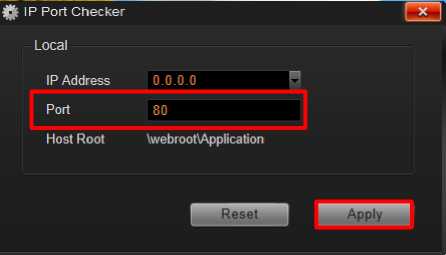
You may just click “Apply” if you are not sure whether this port has been taken or not. If the port is being used by another service, you will be asked to input another available port number.
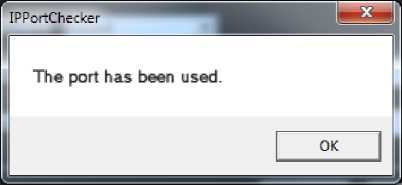
4. As the server port is confirmed, the installation process is done, click “Finish”.
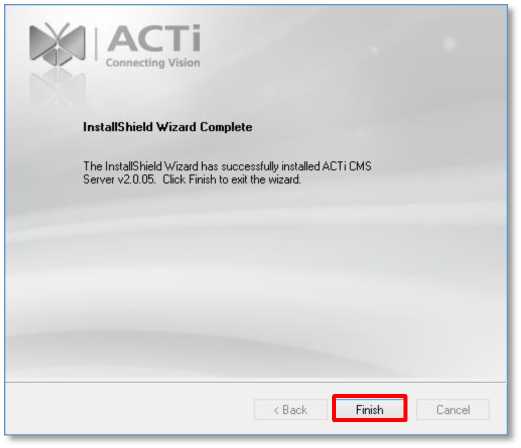
5. After the installation completes, connect to http://localhost:port number with Internet
Explorer browser, you will see CMS Login page.
Note
If IIS Web Server has been installed on the computer and you are asked to restart the computer during installation process, please
- Choose Yes. I want to restart mjj computer now. to restart right away.
- After the computer reboots, this install shield will automatically continue the installation.
CMS2 Workstation provides interface between users and the CMS server. It may be installed on the server computer or on a separate computer with internet access to CMS server.
- Execute install the shield application LE .
- Follow the onscreen instructions of InstallShield Wizard, accept the license agreement and proceed.
fed1ACTi
Connecting Vision
License Agreement
Please read the following license agreement carefully.
Important Notice *
o
Please read the terms and conditions of this license agreement carefully before installing the software. This end user license agreement (EULA) is between you (either an individual, or a single legal entity) and ACTi. By installing the software and clicking on the “agree” button, you agree to the term and conditions of this agreement. If you do not agree to this ▼
^^^ccepÛh^erm^Hh^îcens^^^^^^^ prjnt
ö I do not accept the terms of the license agreement
I nstallS hield
< Back Next> Cancel
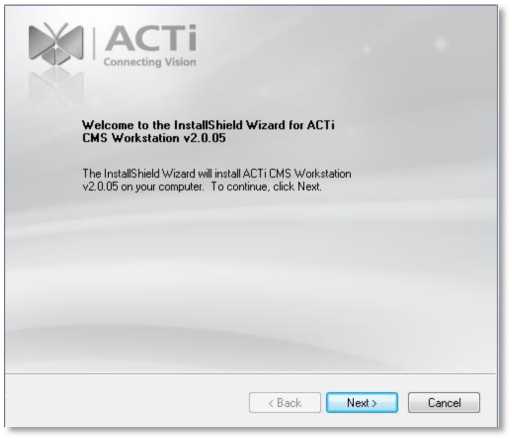
ferf ACTi
Connecting Vision
Setup Type
Select the setup type to install.
Please select a setup type.
o Complete
A” Pr°gfam Matures will be installed. (Requires the most disk space.)
O Custom
Select which program features you want installed. Recommended for advanced users.
I nstallS hield
[ < Back 11 Next > Cancel
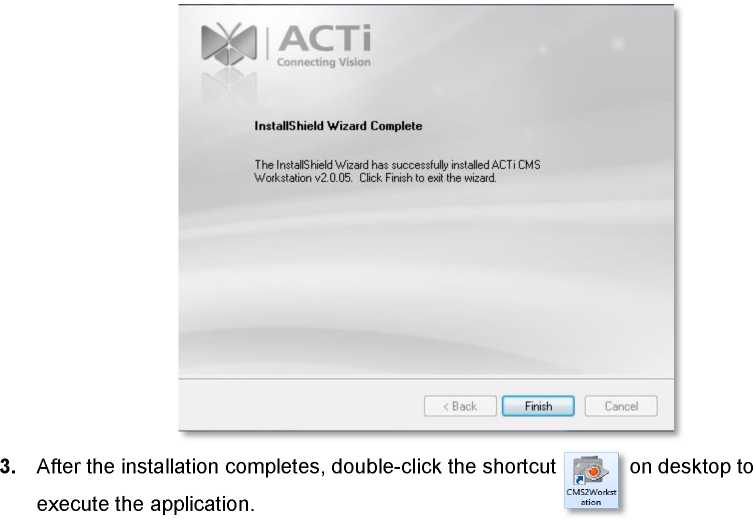
In CMS system, the maximum number of channels is unlimited; your required number of channels should be licensed and activated before adding the devices to the system. To get the license, you may contact ACTi sales representatives to purchase the licenses and obtain the License Key. Upon the activation of license with the License Key, the channels will automatically become available.
•The license is cumulative and perpetual.
•The license is not version-specific, software version upgrading will not influence the existing license you have activated on CMS server.
How Does License Activation Work
License activation is the process of unlocking the channels on CMS server with the received License Key. License Key is a serial number delivered as a printed card or by email after the purchase is carried out. During license activation, your License Key is matched against the MAC address of the Network Interface Card (NIC) on CMS server computer. Once this license key is used by the computer with given MAC, it cannot be activated with another MAC. This matching record will be stored on the activation database. If your computer has more than one network cards, CMS server will detect them and provide you a dropdown list to select from.
There are two ways to activate the licenses depending on your CMS server network condition:
If your CMS server computer has available Internet access, you should take online activation.
| On CMS2 server, input the
Purchase licenses 1 from ACTi, get the Lucense key
J

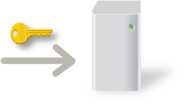 2 LICENSE KEY to activate the license directly.
2 LICENSE KEY to activate the license directly.
CMS server
(Internet access)
Step 1: Membership ID in ACTi Member Center is required for activation. Register one for free at http://member.acti.com/
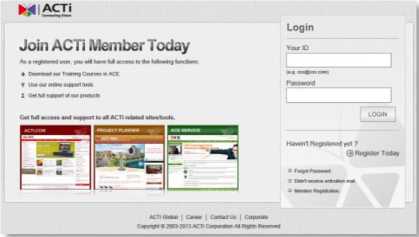
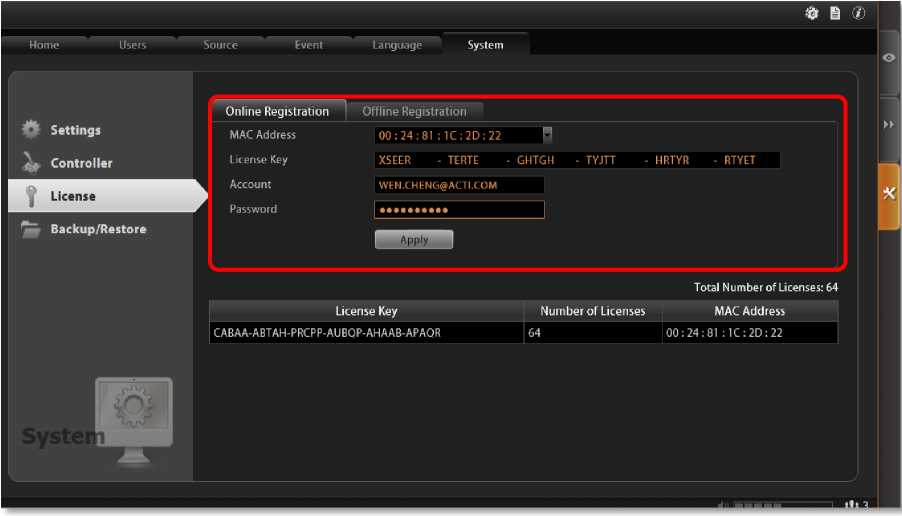 Step 2: Log in CMS server, go to Setup page^System tab^License^“Online Registration”. Select the MAC Address, enter your License Key, member Account and Password, and then click “Apply”. CMS server will connect to the activation database via Internet to register the license key, and unlock the channels.
Step 2: Log in CMS server, go to Setup page^System tab^License^“Online Registration”. Select the MAC Address, enter your License Key, member Account and Password, and then click “Apply”. CMS server will connect to the activation database via Internet to register the license key, and unlock the channels.
![]()
![]()

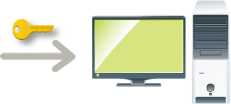
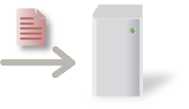
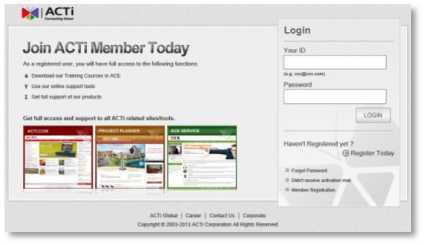
Purchase licenses 1 from ACTi, get the Lucense key J
P Load the 1
3 ACTIVATION FILE
into CMS server
Computer
(Internet access)
CMS server
1. Membership ID in ACTi Member Center is required for activation. Register one for free at http://member.acti.com/
- Access http://www.acti.com/support/LicenseMgt/CMS registration.asp, enter the License
Key and the MAC address of CMS server computer, click “Submit”. An email with
Offline activation does not require Internet access for CMS server. It is used when CMS is located in a network not connected to public Internet (e.g. in a restricted military base). You will need to get an activation file (AUL.lic file) from another computer and transfer it to CMS server computer.
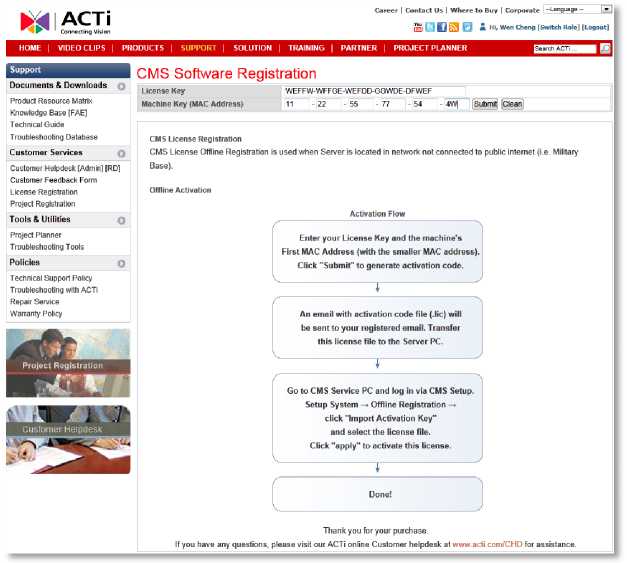 On another computer, access ACTi website to activate the licenses using the
On another computer, access ACTi website to activate the licenses using the
activation code file (AUL.lic) will be sent to your registered e-mail account.
- Log in CMS server from local or via web client. Go to Setup ^ System tab ^ License ^ “Offline Registration”^ click “Import” and upload the license file (AUL.lic). Click “Apply” to activate this license.

Once your license is successfully activated, the license information will be shown on License
page.
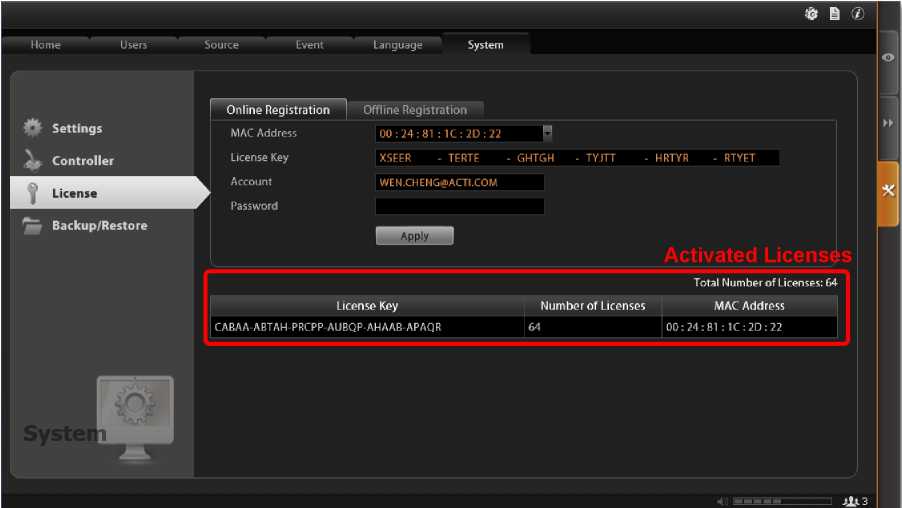
Important
The license data will be erased once CMS server is uninstalled. Be sure to retain your license key information in a safe place because you may need to reinstall the software. After the software is uninstalled, you should contact ACTi Customer Help Desk http://www.acti.com/CHD to clear the ^original registration data in our database, and then you may activate the license again.
Tip
- Click Windows Start, in the run box on Start menu, input “cmd”.
- Execute the cmd program, and input the command “ipconfig /all” or “getmac”
- The MAC address will be referred to as the Physical Address, made up of 12 characters
e.g. 00-1E-65-FE-8E-98
Access CMS via Internet Explorer

httpy/localhosv
Network
220.228.146.21
(Example)
(Example)
From Server Computer Using Local Client
Open Internet Expolrer. If your computer is where CMS server is installed, type http://localhost/ or the computer’s IP address in URL box.
A remote client refers to any client using a computer over WAN or LAN other than server computer. If you are connecting to a CMS server as a remote client, please type server computer’s IP (e.g. local network ip: http://172.16.26.217 within LAN; public IP http://220.228.146.21 or domain name http://cms.acti.com over WAN ) in URL box. If the port number is 80, you can omit it when typing the address.
Accept ActiveX Controls Installation Requests
CMS interface requires the add-on ActiveX Control components, please make sure browser’s security settings allow ActiveX controls to be downloaded and installed. When your browser asks if you allow ACTi Corporation’s add-on components to run, please allow them.
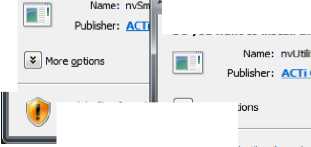
![]()
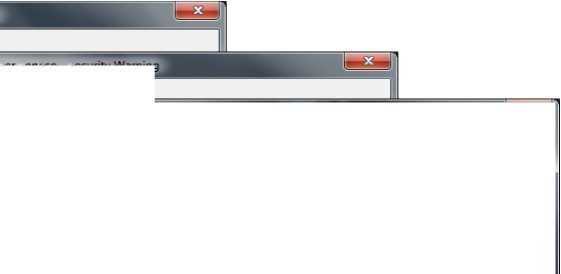
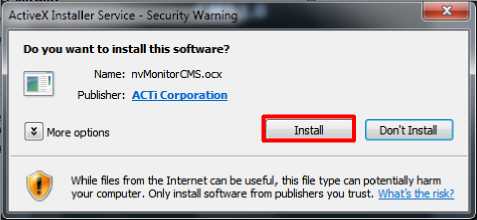
![]()
ActiveX Installer Service – Security Warning
Do you want to install this software?
Do you want to install
) More
While files from fr your computer. 0
While files from your computer.
ActiveX Installer Service – Security Warning
Once you confront with problems accessing CMS server, refer to the possible conditions below and follow the instruction to solve your issues.
Condition 1: Why can’t I access CMS server via my browser?
After typing in the correct CMS server IP, if you cannot access CMS Login page, you may get the below browser screens:
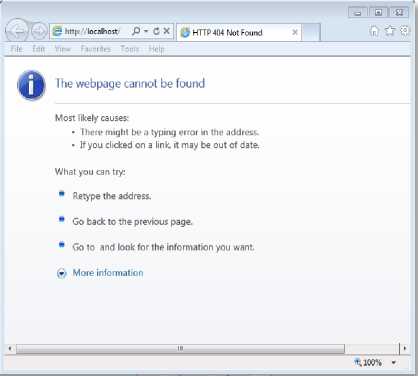
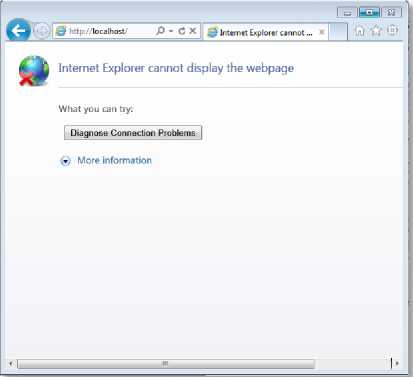
Cause: Server is not ready
Solution: It will take a little while for the server to get ready to run after the installation is completed, please wait a few seconds and connect again.
Condition 2: Why can’t I install Active X controls after logging in?
ActiveX Control components are essential for CMS server to present user interface. The message below will show if these controls were not installed.
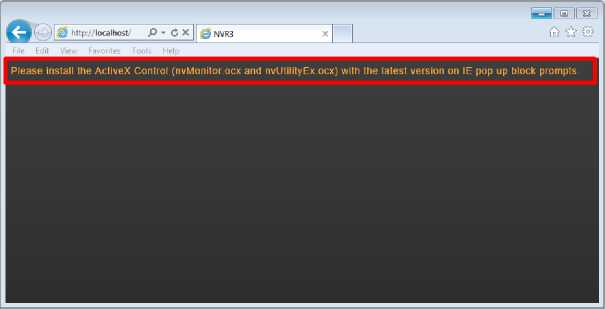
Cause 1: Your Internet Explorer browser version does not support CMS.
Solution: Make sure you are using the 32-bit version of Internet Explorer.
Cause 2: Your browser restricts the installation of add-on components.
Solution: Internet Explorer security settings may restrict the installation of add-on components. To ensure CMS server is always accessible from your web client regardless of any change in browser’s overall Internet security settings, you may add CMS server site to Internet Explorer’s Trusted sites. These sites are which you consider safe and wish to visit with low security restrictions while maintaining higher security for the rest of the Internet.
- On IE browser, click Tools ^ Safety and make sure ActiveX Filtering is unchecked.
- On IE browser, go to Tools ^Internet Options^Security tab, select “Trusted sites”, set the security level to “Medium High”, and then click “Sites”.
- Add http://localhost or server IP to the zone, and clear the box “Require server verification (https:) for all sites in this zone”.
- Back on Security tab, click “Apply” to apply the changes. This will allow ActiveX and
scripting to be available for the chosen sites but not for the Internet as a whole.
sites
You can add and remove websites from this zone. All websites in
this
zone
will
use
the
zone’:
rity settings.
website
the
zone:
Websites:
Require
server
verification
(https:
for
all
sites
[ Remove
this zone
[ Close
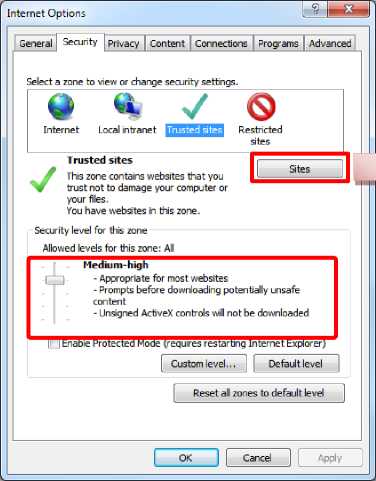
![]()
![]()
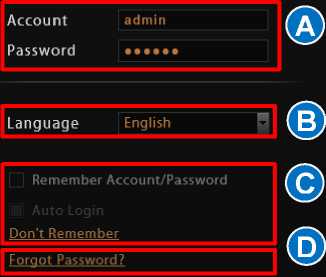
CMSv2.0
Account (non case-sensitive):
Admin (default)
Password (case-sensitive): 123456 (default)
To change UI language, select the desired language from “Language” dropdown list.
![]()
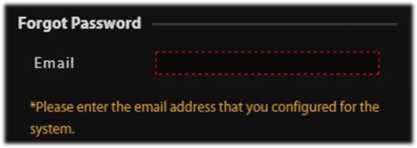
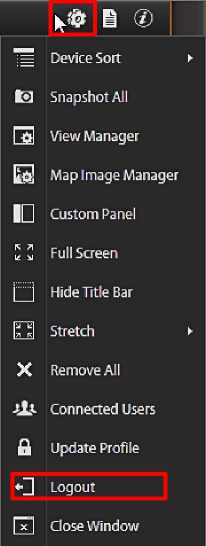
To have the server remember your Login Account and Password for future, check “Remember Account/Password”. Clicking “Don’t Remember” will clear your input text and reset to default.
To directly enter the main page every time you log in from this PC in the future Check “Remember Account/Password” then “Auto Login” to skip the Login page. If your computer may be accessed by someone without proper authority, please DO NOT use either of these functions.
To cancel auto-login, on title bar, click G ^ “Logout” to return to login page, and this function is cancelled.
CMS Server can send the password of the User’s account to the saved email address. To have Users be able to use this service, please make sure (1) the SMTP settings have been configured (refer to How to Setup SMTP Settings for Event Rules on page 53) and (2) a valid email address has previously been saved in Setup page ^ Users tab ^ User list.
The email address input in Forgot Password window should match the one under your User account saved in CMS server.

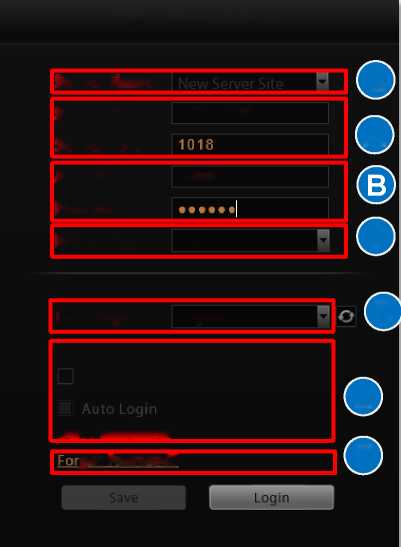
application.
CMS Workstation
G
Server Name
Server IP
172.16.26.91
A
Server Port
Account
admin
Password
C
Initial Page
Live
D
Language
English
Remember Account/Password
E
Don’t Remember
F
got Password?
| Live | H |
|---|---|
| Live | |
| Playback Setup | * |
Access CMS Server via Workstation
CMS Workstation includes a set of programs that provide interface between users and the CMS server. It may be installed on the same PC as the CMS server, or on a separate client computer.
Double-click the shortcut icon on your desktop to execute this workstation
Fill in the following fields then click “Login” to log in to the system. The login process of
Workstation is very much the same as that of Web browser:
In Server IP field, key in localhost or 127.0.0.1 if CMS Workstation is on the same computer with CMS server. If you are connecting from a non-server computer, please input the IP address of server computer, for example: 220.228.146.22.
In Server Port field, key in the port number (default is 80).
Account (non case-sensitive) Admin (default)
Password (case-sensitive) 123456 (default)
CMS user interface consists of three main module screens: Live
View, Playback and Setup, you may choose one where you would like to enter after logging in. Default is Live View screen.
Choose a UI language from drop-down list.
| i | |
|---|---|
| Device Sort ► | |
| Snapshot All | |
| S | View Manager |
| £3 | Map Image Manager |
| ID | Custom Panel |
| R 7İ
U 14 |
Full Screen |
| lJ | Hide Title Bar |
| n | Stretch ► |
| X | Remove All |
| Connected Users | |
| fi | Update Profile |
| *3 | Logout 1 |
remembered.
To have CMS2 Workstation remember the Account, Password, your choices of Initial Page and UI Language, simply check “Remember login info”. Click “Don’t Remember” will clear your input text and reset to default.
To directly enter the desired page every time you log in from this PC , check “Remember login info” then “Auto Login” to skip the Login page. If your computer may be accessed by someone else, you might consider not to use either of these functions.
To cancel auto-login, on title bar, click EZ ^ “Logout” to return to login page, and this function is cancelled.
Please refer to D. Retrieve the Forgotten Password on page 28.
CMS2 Workstation can remember multiple server sites and their login settings and show the
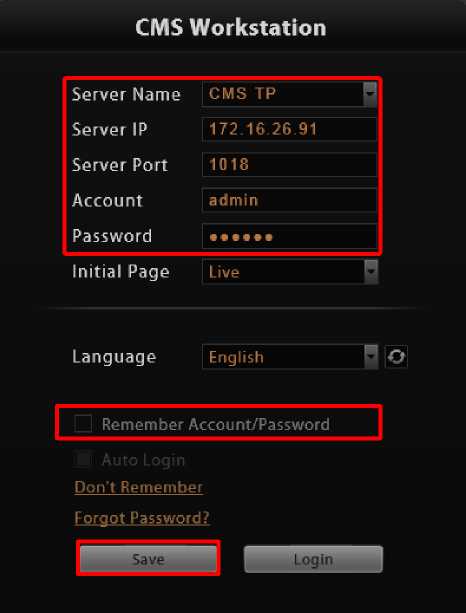 1. Click in the Server Name box and input the server site name.
1. Click in the Server Name box and input the server site name.
site lists on Login window. To add a new site:
2. Fill in the other fields. If you disable the “Remember Account/Password”, then only the Server Name, Server IP and Server Port of this server site will be
You may click on its name to enter its
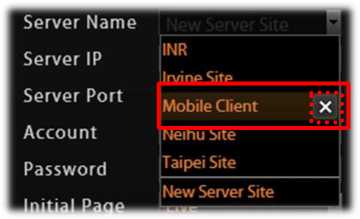 Login window or 0 to delete it from the
Login window or 0 to delete it from the
list.
Access CMS server via CMS2 Workstation, go to Setup page ^ System tab ^ Workstation.
Click “Browse” to select a folder to save the list, and then click “Export”. This file will be saved as an *.xml file.
Click “Browse” to select the *.xml file, and then click “Import”. The server sites will appear in Server Name dropdown list on Login window of your next login.
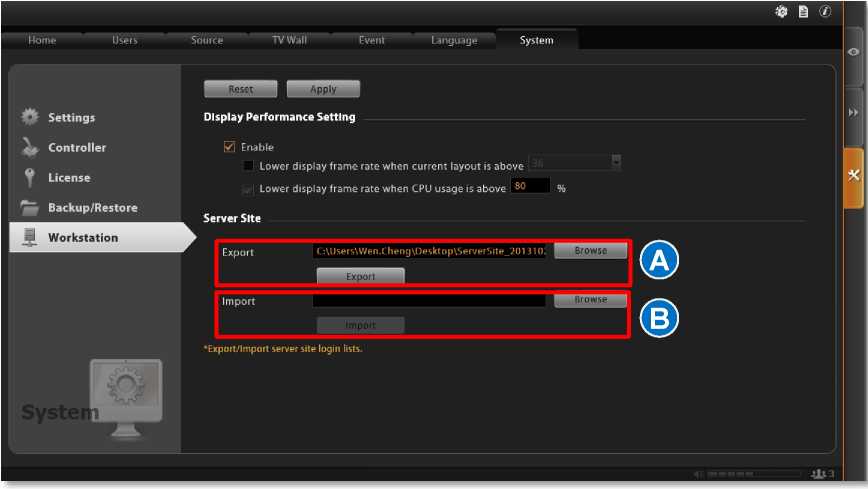
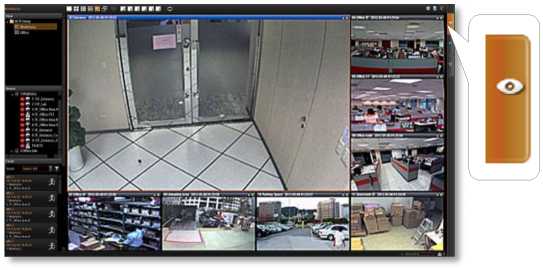
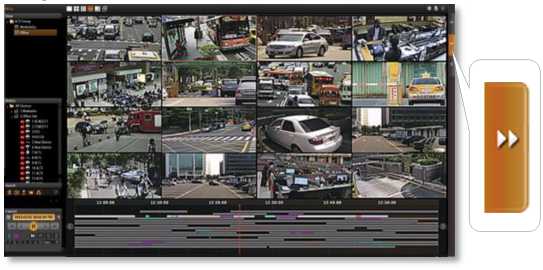
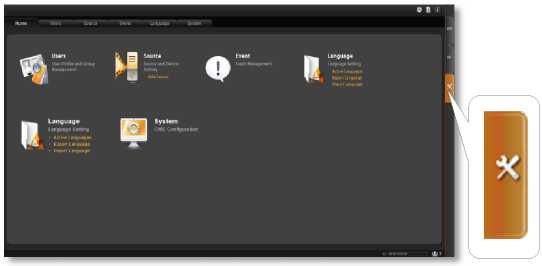
Live View
Playback
This module includes user setup, NVR source/device setup, TV Wall setup, event setup and CMS system-wide settings.
This chapter will guide you through everything you need to know in System Setup procedure from first time connection with CMS server to general system configuration.
On the right are link buttons to three CMS major functions: (1) Live View, (2) Playback and (3)
Setup. You can click the orange button to enter the function page.
In this module, you can see live view from NVRs, perform PTZ operations with a mouse or a joystick, view system log, receive alerts on the event panel, set view layouts, perform manual recording or take a snapshot.
You may search and play existing recordings in multiple channels synchronously. Snapshots or video segments can be taken from playback files. Recorded files can also be exported to AVI format here.
The User Groups/Users page allows you to (1) manage the access permissions of different user groups, (2) add users to or delete them from user groups, (3) assign users to specific user group. This chapter will take you through these settings.
In CMS, the access permissions are managed by User Groups. User Groups defines which CMS operations and NVRs are allowed for the group users. Different User Groups will have different access rights. For example, an Administrator User is allowed for the complete operations in CMS system, while a standard User may only be permitted to see Live View and do Playback with limited NVRs. The chart below displays an example consisting of different employees as CMS Users and their access rights in this system:


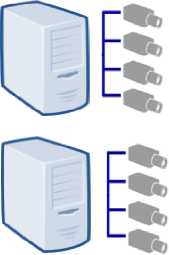

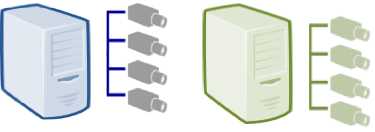
Limited Group
Monitor
Security Group
Monitor
Playback
Setup
Go to Setup page ^ Users tab. There are two sections to manage User Groups and Users individually.
User Groups: To setup user groups and its permissions for device and functionalities.
Users: To manage user accounts and configure user information.
CMS has integrated Microsoft Active Directory® service to provide network administrators a more convenient choice for user management. Active Directory is a directory service built in Microsoft Server products to manage user identities and privileges within the domain network. As CMS runs on a server computer logged on to the same domain with an Active Directory
►4 ACTİ
Connecting Vision
server, you can import a user account or a group from those concurrently existing in Active Directory into CMS server. In this way, the user identification is processed by Active Directory centrally, and there is no need for CMS administrator to maintain these user accounts.
You can specify access permissions to each NVR for an entire user group. This user grouping can save you significant amount of works if you have multiple users performing similar tasks and acting as similar roles.
There are already two default User groups
- Administrator: With full permissions in CMS interface.
- User: With the permissions to watch all camera live view and playback(Default).
The Administrator User is predefined with full permissions in the CMS server, and cannot be deleted. You can choose to create a new user group on CMS server or import an existing group from the Active Directory database within your domain.
•Add a new user group:
Insert ID, group Name and group Description, your input in the Name field will be the name of this User group. Click “Apply” to finish.
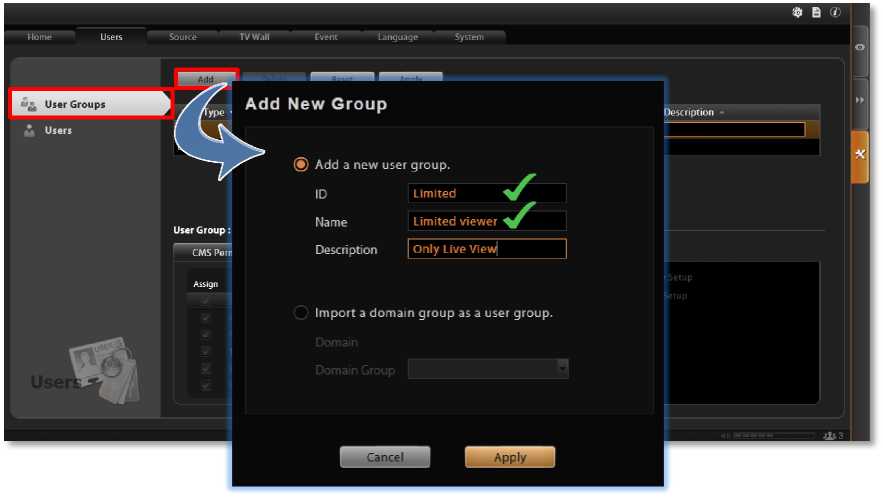
• Import a domain group as a User group:
Choose an existing user group from your domain, and click “Apply” to finish.
Add New Group
C Add a new user group.
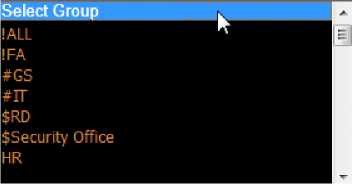
Name
Description
Domain: ACTi.c
® Import a domai
Domain Group ‘ Select Group
Blank is not allowed or format error for required fields.
The domain users within that group will all be added to CMS server at the same time. To view the whole users within this group, please select Users 2 and enable the “Show
users in domain groups.” The account information of these domain users, unlike those user
accounts you add one by one to CMS server, are not editable on Users page.
| 0 Show users in domain groups | Ü Clear Al 10 Select All | |||||
| User Type ■* | User Account | User Name | Password | Group Name | ||
| Customized User | admin | Admin | Administrator | |||
| Domain User | Deckard Cain | Deckard Cain | Deckard.Cai@acti.com | $Security Office | ||
| Domain User | John.Bourne | John.Boume | John.Bourne@acti.com | $Security Office | ||
| Domain User | Steve.Lin | Steve.Lin | Steve.Lin@acti.com | SSecurity Office | ||
| Domain User | Joyce Holiday | Joyce.Holiday | Joyce. Holiday© acti com | General Service 1 | ||
Domain users added as a whole group
group is allowed to access. By default, a User group will initially be allowed to access only
Live View page and Playback page on CMS, but without any permission to CMS or NVR

settings, so you may have to assign the Source Permissions later.
3. Assign Source Permissions for created groups. This will define which NVRs this User
group is allowed to access. If this User group is allowed to access later-added NVRs, check
“New Source Default” and edit the permissions.
| CMS Permissions ‘ Source Permissions TV Wall Permissions | |||
| – | |||
| 0 Device Unified Settings
Assign |
New NVRs | ||
| 0 New Source Defaul | |||
| Existing NVRs
[vj Storage Setup 0 System Setup 0 Add New Device |
|||
| 0 INR
0 ENR |
|||
| 7 | |||
You may individually check the NVRs this user group is allowed to access, and set the permissions to configure NVR settings.

You may also enable the permissions related to a specific camera under the NVR.

Instead of tailoring the settings for each device, you may click “Device Unified Settings” and
set universal settings, which will be applied to any device you check under this NVR.

You may copy the Source Permissions Settings to other sources. Click “Copy” under Source Permissions tab to bring up the target NVR menu, check the target sources, and click “Apply”.
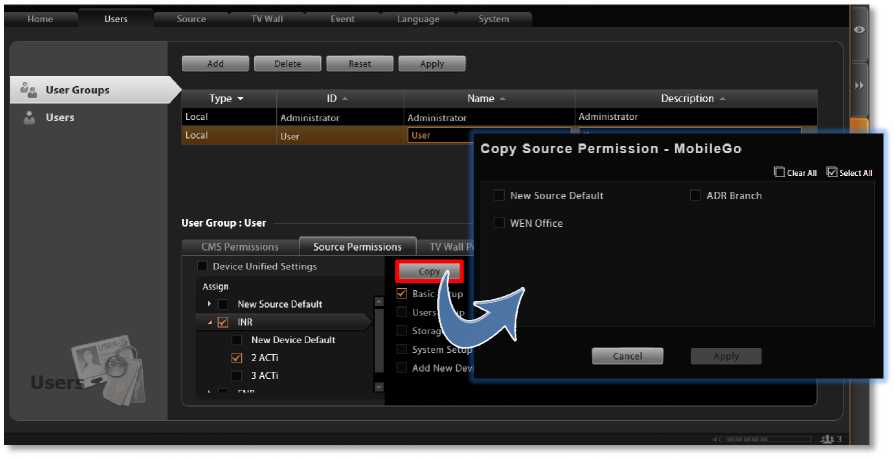
Click “Apply” on the top to save the settings.
To create a user account with on CMS server.
•Customized User: an account created and managed on CMS server only. You will input an account name, its password and e-mail address for this User.
•Domain User: an account that already exists in Active Directory database within the domain. Since this is an existing account in your domain, you will have to select this account from Account dropdown list.
- Insert user account, name, password, and the account e-mail (For Customized User).
- Assign this created user account to a specific user group.
- After you click “Apply”, this new user will be added to the list on the top.
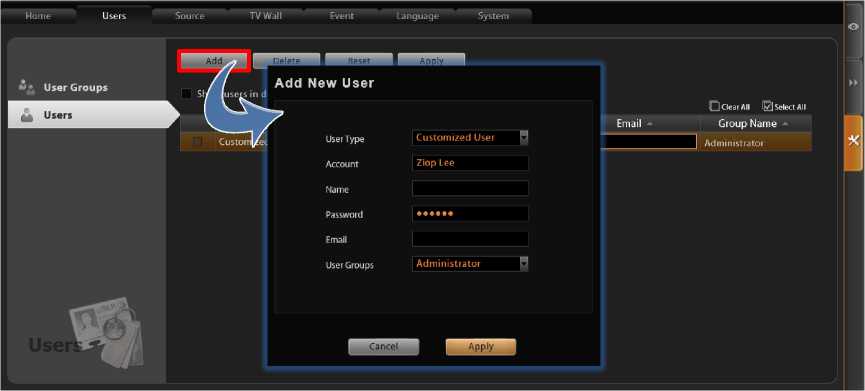
Note
CMS server provides a procedure to help Users who have forgotten the password retrieve the original information, which relies solely on the “e-mail address” authentication. It is strongly recommended that you input an e-mail address that this User has access to when you establish the User account. To update the e-mail address of an account, go to Setup page^ Users tab ^ edit “Email” of an selected User account; the Users can also update the e-mail addresses themselves after logging in to CMS on Live View page ^ ^
Update Profile
Note
- Account and Password fields allow alphabets, numbers, and symbols except the following: / \ [ ] : ; | = , + * ? < > “
- In Account field, for alphabets, the input will be recognized as lowercase letters. Space is only allowed between characters; the space in the beginning or at the end will be deleted when it is saved.
- The Password field is case-sensitive, and the space is allowed.
Note
Admin is the default user account and belongs to “Administrator” user group. Hence, the user Admin and its group Administrator cannot be deleted; it possesses full permissions to all NVRs, devices, and CMS settings.
As CMS server computer is logged on to a domain Active Directory, it can import a user account from Active Directory.
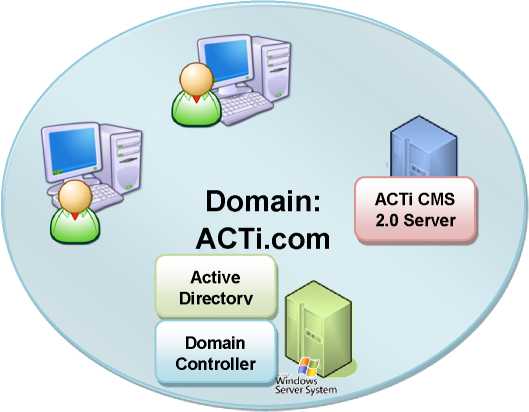
This type of User account is “Domain User”. Upon being added to CMS server, the User properties stored on Active Directory database including account name and e-mail address will
be imported to CMS server.

Whenever the Domain User client tries to log in to CMS server, CMS server will first verify if
this account exists in CMS server database, if not, it will then have Active Directory verify the user account and password.
As Active Directory owns the privilege to create, edit and delete domain users, the Domain User’s account and password are not editable through CMS user interface but via Active Directory Administrative tool.
A CMS server manages multiple NVR severs, whose fundamental building blocks are the cameras or video encoders. The first thing you should do after you have registered the license is to setup your NVR connections in CMS Setup page. In this section, we will guide you through how to manage the NVRs and their devices.
To start adding a new NVR, please follow steps as below:
1. On Setup page^ click “Source”. There is no source in All Sources list. Now click “Add
Source”.
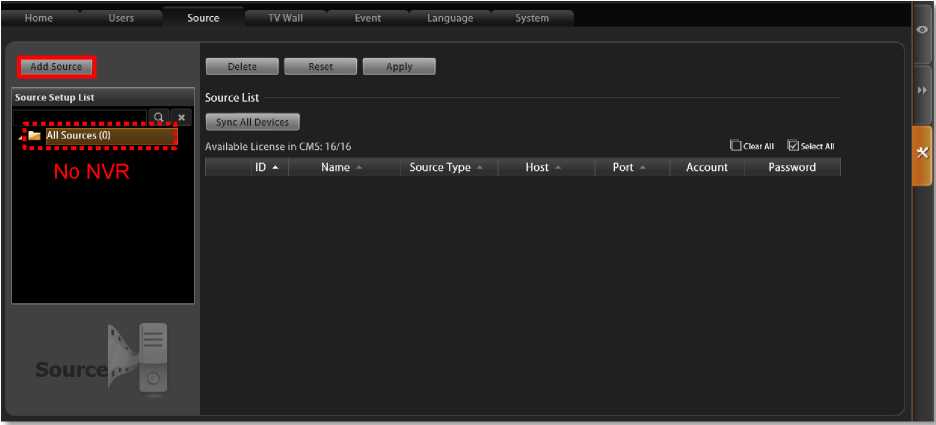
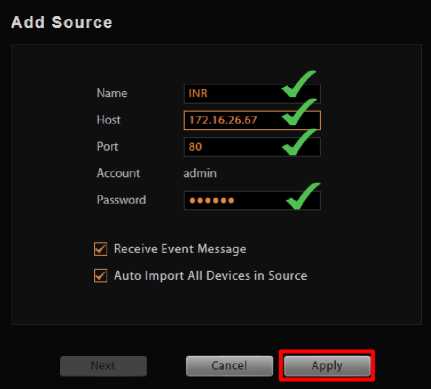
2. On the Add Source window, fill in the following fields and click “Apply”: •Name – title of this NVR
•Host – the NVR’s IP address
•Port – the NVR’s port number
•Password – the Administrator’s password of this NVR. By default, all the devices in the NVR will be automatically added to CMS server after you click “Apply”. If you want to select only the desired devices rather than import all the devices at this stage, de-select “Auto Import All Devices in
Source” before clicking “Apply”.
In most cases, with limited licenses, you do not import all devices of all NVRs to your CMS server. After an NVR is added, you may start selecting your desired devices to be imported to CMS server. Once a device is imported, on CMS interface you can (1) modify this device directly, (2) see its live stream ,(3) receive the instant event notifications from this device and (4) watch the recorded video of this device.
- On All Sources list, select this NVR, the Using Devices list on the right will display the imported devices. By default, all the devices of an NVR were already imported as you added it to CMS server.
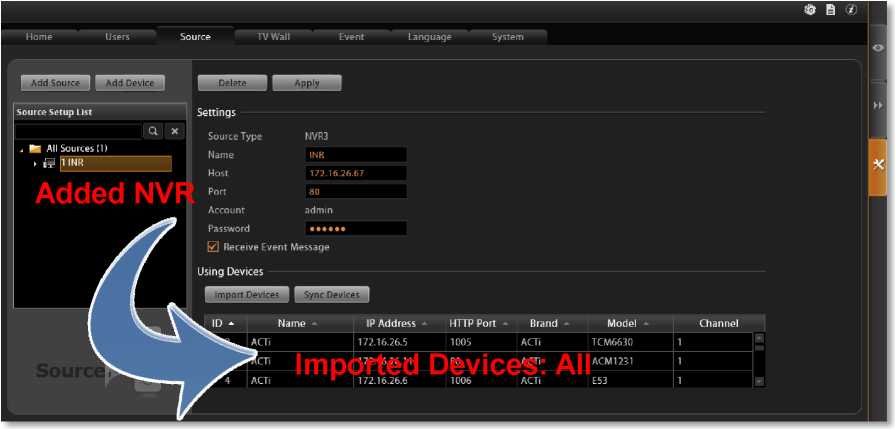
2. If you have unchecked the box “Auto Import All Devices in Source” when adding this
NVR source, you have to select the devices to be added by yourself.Click “Import Devices”
to enter NVR device list.
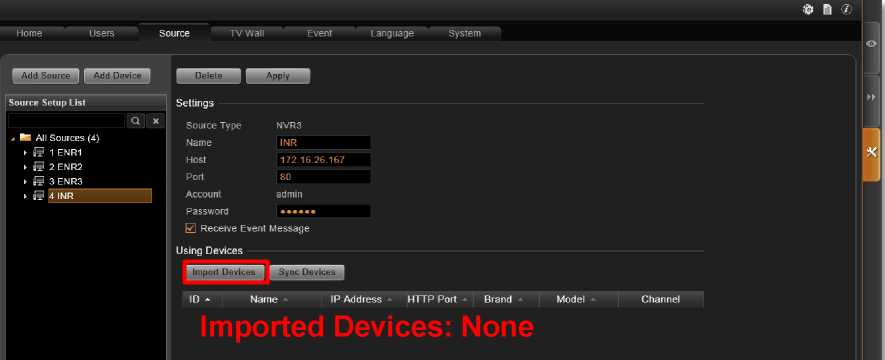
want to import and click “Apply”.
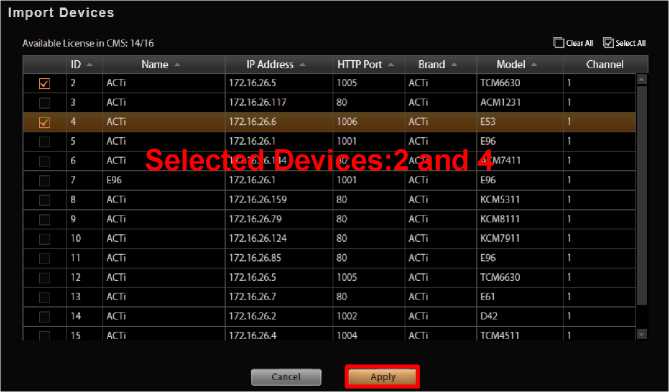
Devices list.
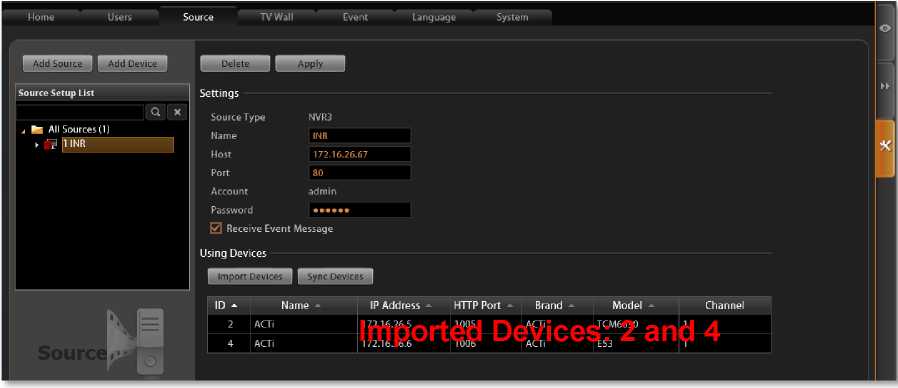
The configurations done on NVR site will not be synchronized with CMS server actively. For example, an NVR administrator may replace several cameras (which have also been imported to CMS server) with new ones, and therefore the CMS site would lose the connections between those replaced cameras. On CMS site, you can synchronize with an NVR server via one click:
- Go to Setup page ^ Sources tab, on All Sources list, select this NVR.
- On the right, click “Sync Devices” button.
- Click “Apply”.
Tip
Whenever your CMS server loses connections with certain devices, it is always suggested that you click this button , sync Devices t first, since the loss of connection probably resulted from some changes done on the NVR site.

You may centrally manage multiple NVRs on the All Sources Setup List easily.
Go to Setup page ^ Sources tab. Under
j M All Sources
lists all the NVRs you added.
To locate a specific NVR in the All Sources tree, you may input the keyword in its name in the search bar, click to start searching, and click I to show all sources.
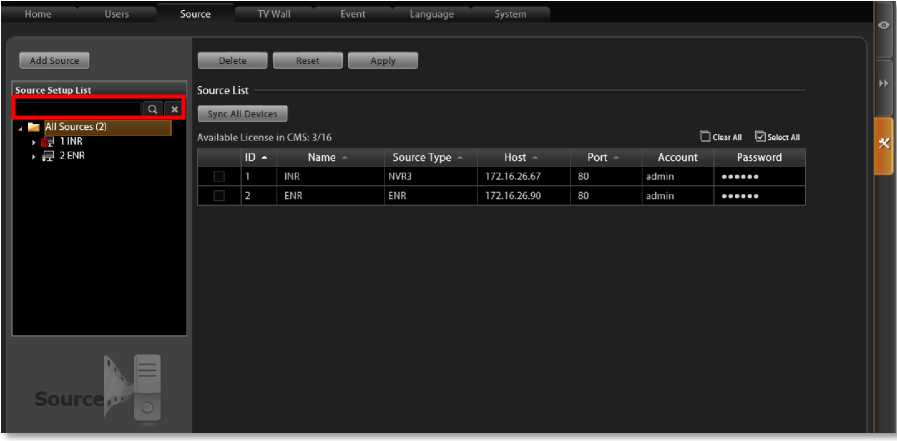
Delete NVRs
All Sources
Highilight
, a list of connected NVRs will appear on the right. Select the NVRs
you want to delete, and click “Delete” then “Apply”.

Highilight
and click “Sync All Devices”, CMS server will synchronize with all
M All Sources
the NVRs and imported devices.
Configure NVR / Devices Settings
As CMS administrator owns unrestricted rights to control all the NVRs and their devices, it is sometimes more convenient to modify the NVR settings directly from CMS interface. On CMS
Source management page, you may change any property of an NVR or its devices.
NVR Settings
To enter an individual NVR’s settings, Go to Setup page ^ Sources tab, on All Sources list,
to expand its sub category. By selecting a title, the setup page will appear on the right. Any change applied to the NVR will be saved to both
select an NVR, and click on the arrow
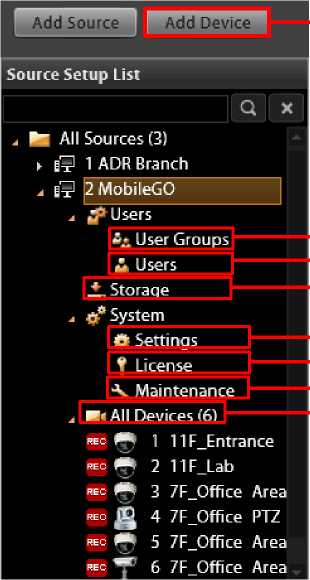 Add Devices to this NVR by auto-search or manually
Add Devices to this NVR by auto-search or manually
NVR itself and CMS server.
Device Settings
NVR User Group/Permissions management
NVR User Account management
NVR Storage setup
NVR System setup (Email/SMTP/FTP/Export folder/UI style)
NVR License management
NVR Backup/Restore/Language file management
NVR Device list
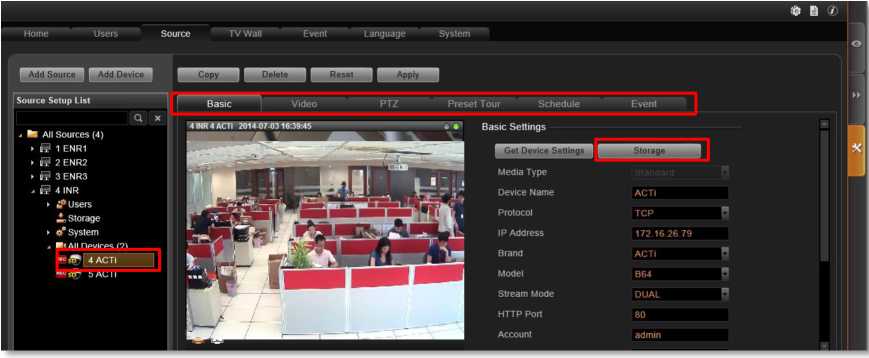 To configure the settings of a device, select the device from Source Setup List, and modify
To configure the settings of a device, select the device from Source Setup List, and modify
the available settings on the right.
Note
Please note the following before applying any change to an NVR server:
- It is strongly recommended that you make a backup of the original NVR settings.
- Only the devices in the same network segment with the selected NVR can be found or manually added by clicking “Add Device”.
- To modify a device’s schedule or event rules, please select the device and enter the Schedule or Event tab on the right.
- The customized views saved on an NVR server cannot be configured via CMS interface.
- ENR system settings and storage settings are accessible only via ENR interface.
On Live View screen or Setup page ^Source tab, the icons shown under All Sources category will display the status of each NVR server as well as the devices.
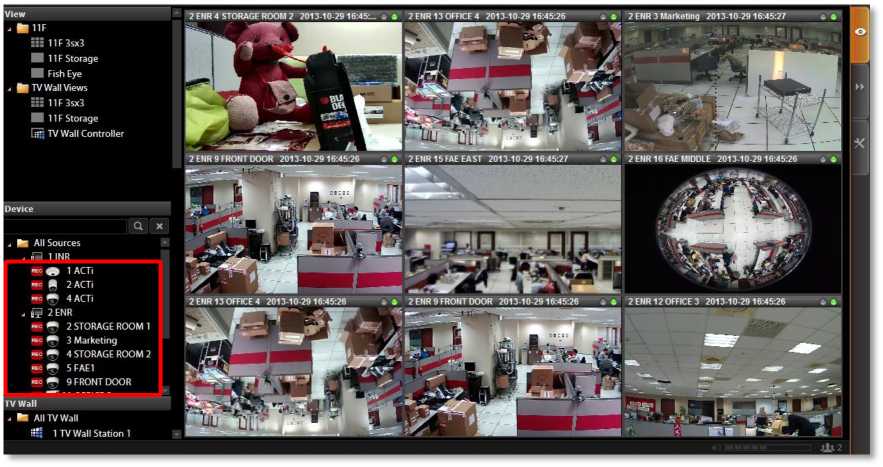




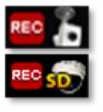

Example Icon
Status Description
Video loss:
CMS cannot retrieve the video stream.
Modification has not been saved:
This device’s settings have been modified but not saved yet. If you leave these modifications unsaved, they will not take effect.
Connection loss:
CMS cannot build up connection with this NVR or device. Please check the connection settings (including IP Address, Port number, Account Name and Password); or increase the “Connection Timeout” to allow more time for the device or NVR to respond.
Disk Full:
The storage space of this NVR server is full, and no recording is taking place. You will need to go to Setup ^ Source tab and configure the Storage settings in Source Setup List.
Recording:
This device is currently connected, and video is being recorded either manually or according to the schedule. The orange “SD” sign indicates that this device supports local storage.
Connected:
This device is currently connected, and the video stream is viewable on Live screen.
You have blocked the system event messages sent from this server, which means the current status of this server is invisible now.
Under CMS’s management, an event detected by a single device can be notified not only to the NVR clients but to CMS clients at the same time. For example, once a camera detects a motion, both an NVR client and a CMS client can receive the alerts via emails. To do so, you have to set even rules in CMS Setup page ^ Event tab. The event rules set here will be independent from those set on NVR.
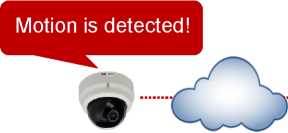
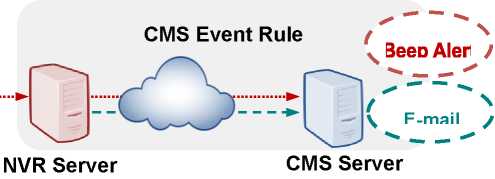
Camera
Server disk is full!
Go to Setup page ^ Event tab. All the editable event rules are listed on the right.
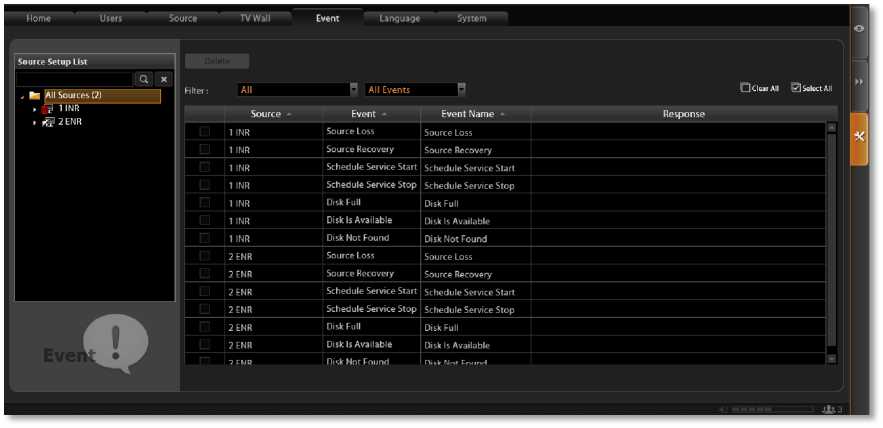
An event rule set for an NVR will trigger actions to notify CMS client.
can be set as event triggers – Source Loss, Source Recovery, Schedule Service Start, Schedule Service Stop, Disk Full, Disk is Available and Disk Not Found.
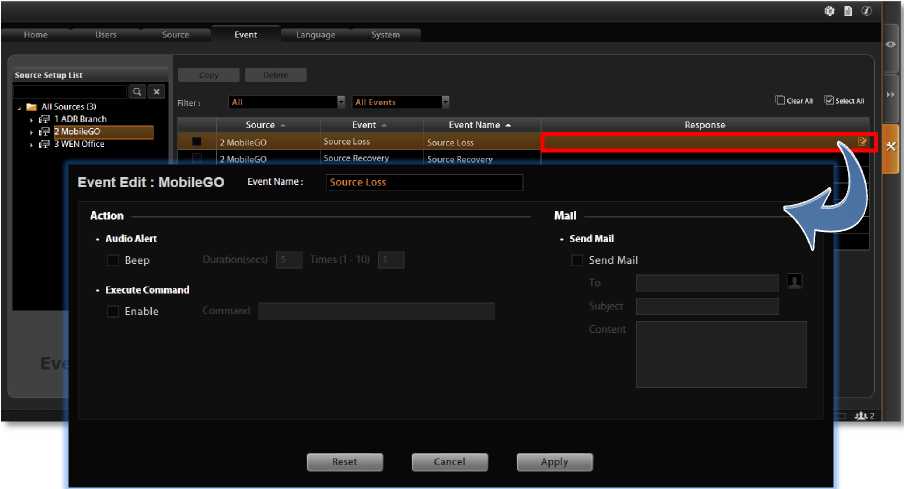
- Highlight the rule you wish to edit. Double-click the “Response” field to edit the response action.
- On Event Edit window, you can enable multiple response actions by first checking the box(es) to enable the items:
Action Items Function Description
Set to play beep sound for a number of repetitions.

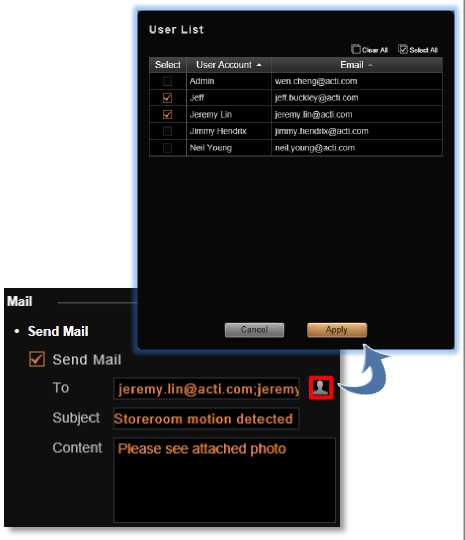 On CMS2 Workstation client computer, you can upload a WAV file or an MP3 file as the alert sound, and set how many times this audio file is play when event occurs.
On CMS2 Workstation client computer, you can upload a WAV file or an MP3 file as the alert sound, and set how many times this audio file is play when event occurs.
| * Audio Alert | Times (1-10) 1 | | |
|---|---|---|
| n | Duration(secs) 5 | |
| * Audio Alert
[LI Beep |
Duration(secs) | 5 Times (1-30′ | |
| 0 Audio File | Path C:\tokyo hot .mp3 | |
| Times (1-30) 1 | ||
Beep and Audio file responses cannot be executed at the same time.
Enables CMS server to execute a specific command upon this event. You can use it to integrate CMS event with other programs. Enter the path of the command to be executed upon event.
Enables CMS server to send an email notification via SMTP server. The default SMTP and sender’s e-mail settings can be set in advance in
Setup page ^System tab^Settings ^ Email& SMTP Settings.
- Type one or more recipients’ email addresses in “To” column (if more than one, please separate them by “;” symbol) or click the O icon to select recipients from existing NVR User list. The User’s Email address should be set in advance (in Setup page^ Users tab^ Users) so that it can be selected in this list.
- Edit the e-mail subject and content.
An event rule set for a specific device will trigger actions to notify CMS client.
Select an NVR, click the arrow
re
to expand its sub-categories, and select the device.
There are five types of device status that can be set as event triggers – Motion, DI Trigger,
Video Loss, Video Recovery, Network Loss and Network Recovery.
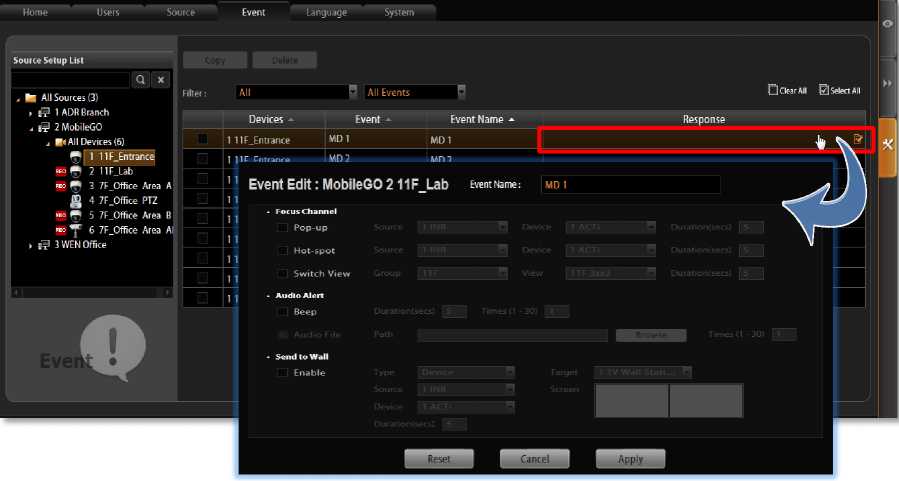
3. On Event Edit window, you can enable multiple response actions by first checking the
box(es) to enable the items:
Action Items Function Description
This kind of action will focus your attention on the channel on client’s Live
| • Focus Channel | |||||||
|---|---|---|---|---|---|---|---|
| 0 Pop-up | Source | \2 ENR | a | Device | 9 FRONT DOOR Q | Duration(secs) | |
| 0 Hot-spot | Source | 1 2 EHR | H | Device | 5FAE1 Q | Duration (secs) | |
| Group | Duration(secs) | ||||||
View page when triggered.
Pop-up:
Brings up event pop-up playback window of selected channel upon trigger. You may also define the display duration of video on the window.
Hot-spot:
Displays video in Hot-spot window (red flashing frame) upon event. You may also define display duration of video on the
Hot-spot window
You may also define duration of the temporary View. Only Public Views are selectable for Switch View event rule.
Hot-spot and Switch View responses cannot be executed at the same time.
| Focus Channel 0 Pop-up | Source | 2 ENR | E | Device | 9 FRONT DOOR | E | Durationfsecs) 5 |
|---|---|---|---|---|---|---|---|
| B Hot-spot | Device | Duration(secs) | 5 | | |||||
| 0 Switch View | Group | 111F | H | View | 111F 3sx3 | Durationtsecs) 3 |
The current Live View will be switched to another one for a while. To enable this option, you will need to customize and save Views on Live View screen first.
Makes CMS client computer play beep sound for a number of repetitions.

 On CMS Workstation client computer, you can upload a WAV file or an MP3 file as the alert sound, and set how many times this audio file is played when the event occurs. (This CMS server has to be already on Server Site list, see G. Server Name/Server Sites List on page 30)
On CMS Workstation client computer, you can upload a WAV file or an MP3 file as the alert sound, and set how many times this audio file is played when the event occurs. (This CMS server has to be already on Server Site list, see G. Server Name/Server Sites List on page 30)
| • Audio Alert | ||
|---|---|---|
| 0 Beep | Duration(secs) 5 | Times (1-10) 1 |
| Audio Alert
| Beep |
Duration(secs) | 5 Times (1-30) | 1 | |
|---|---|---|
| 0 Audio File | Path C:\tokyo hot .mp3 | i|||İ®|| Browse ] |
| Times (1 – 30) 1 |
Beep and Audio file responses cannot be executed at the same time.
Pushes any of the following to a designated TV Wall monitor: a specific live view of a device, a customized CMS View, all devices of an NVR, or a TV Wall View Set to. Please check the box “Enable” first to enable this configuration:
Select Type as “Device”, the NVR Source and the Device name, define how long this live view will stay on the screen, and click the monitor from the Target TV Wall station you select on the right.
Select Type as “Source” and the NVR Source, define how long this live view will stay on the screen, and click the monitor from the Target TV Wall station you select
nn tho rinht
| Send a CMS View
Select Type as “View”, the name of the View Group, and the View name, define how long this live view will stay on the screen, and click the monitor from the Target TV Wall station you select on the right. |
|||||||
| – Send to Wall
0 Enable |
Type View
Group 11F View 11F Storage Durationfsecs] 5 |
Target 1 TV Wall Stati… B
Scree 1 1 |
|||||
| • Send to Wall
E Enable |
Type TV Wall View
TVWall 1 TVWallStati..r3 View View Set 1 3x3_l W Duration(secs) 5 |
Send a TV Wall View Set
Select Type as “TV Wall View”, the TV Wall station, and the name of the View |
|||||
| Set, at last, define how long this live view will stay on the screen. | |||||||
To validate if this rule is successfully set, please make sure you have properly configured the involved settings like Motion Detection Regions or hardware devices like an audio speaker.
Event List panel gives an overview on event rules set on the CMS server. Go to Setup page ^ Event tab ^ select All Sources on the left. As the entire available rules of all NVRs are listed here, you may want to sort out some of them from the long list.
To sort by NVR Source name or Event Name, click the titles to list the entries in ascending or descending alphabetic order; another way is to click an NVR source of a single device in
Source Setup List to view their own event rules.
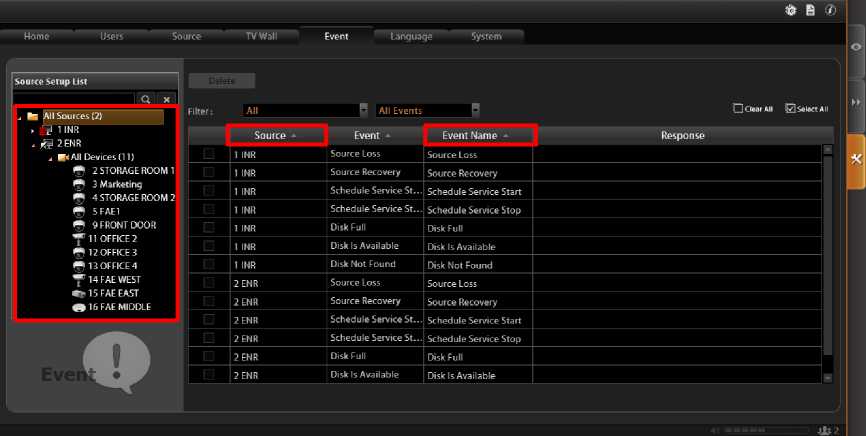
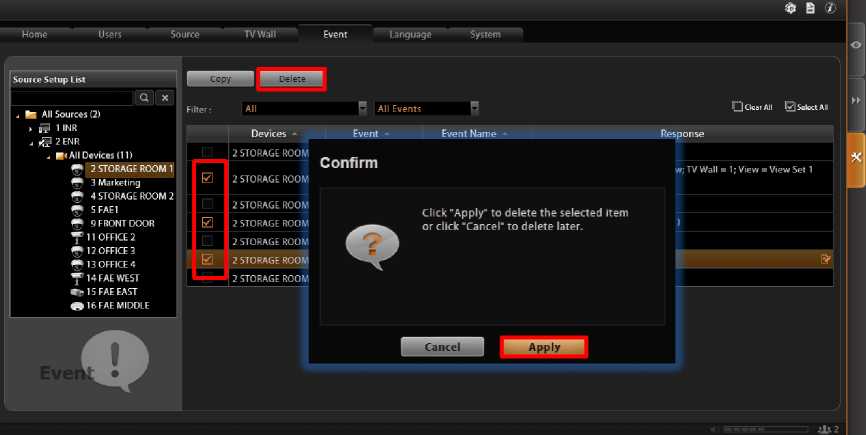
On Event List, select the rules you wish to delete, and then click “Delete” to clear this rule.
How to Setup SMTP Settings for Event Rules
CMS supports email notification sent through an SMTP server. You can specify the email and
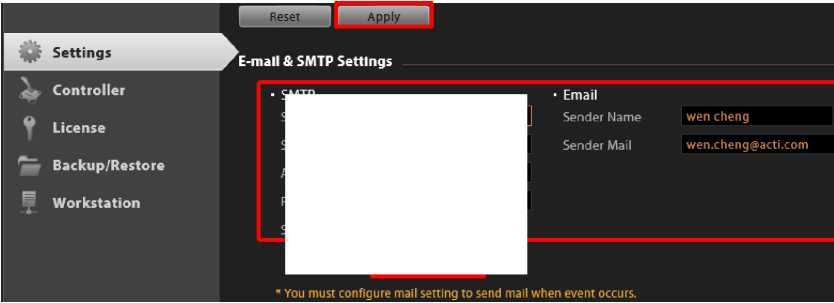
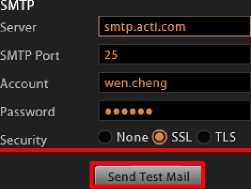
server settings here.
1. Go to Setup page^System tab^Settings ^ Email& SMTP Settings.
Fill in each of the following fields.
| Field Name | Description |
| Server | Input the sender’s SMTP server address. Only alphabets, numbers, and the symbols (.), (_), (-) are valid. |
| SMTP Port | Set the SMTP port, allowed value is from 1~65535, default is 25. |
| Account | Input the name of the SMTP server account. Only alphabets, numbers, and the symbols (@), (.), (_), (-) are valid. |
| Password | Input the password of the SMTP server account. Only alphabets and numbers are valid. |
| Security | Certain webmail providers provide the SSL/TLS-encrypted SMTP connections to secure your data when sending/receiving e-mails. Please check if the SMTP |
| connection settings you use (especially the SMTP Port) now require to enable either SSL or TLS. | |
| Sender Name | Input the name or title of the sender. You may input a name different from the account name. |
| Sender Mail | Input the sender’s e-mail address, which should be the same account you set for SMTP server. |
- As all necessary information is filled in, click “Send Test Mail” to try sending an email according to your settings, and then log in to your SMTP server to check incoming emails. If the test mail is sent successfully, CMS server is ready to send out emails.
- As the settings are confirmed, click “Apply” to save.
The activities performed by logged-in Users are recorded on server as System Log. With the access permission, a user may view, search and export this record for analysis or investigation. This section will provide the instructions on how to read and search data in the system log.
“System Log” Q is one of the resident buttons on top of CMS server user interface, click it to enter either “CMS System Log” or “NVR Source System Log”.
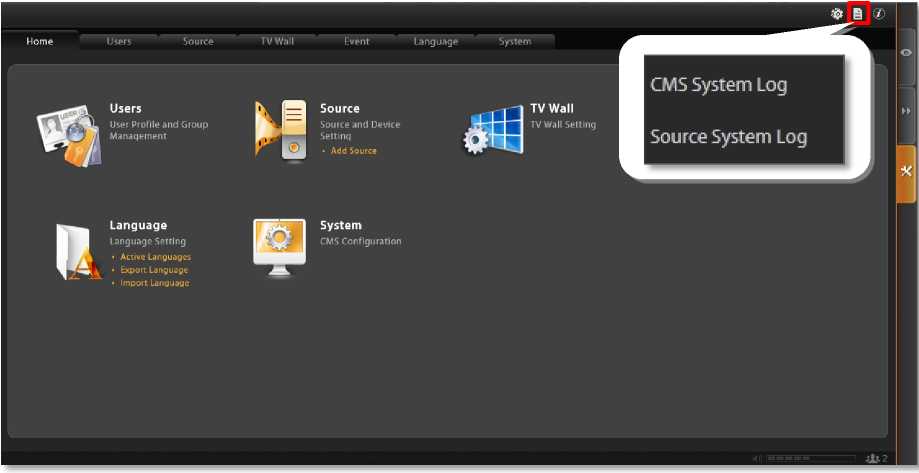
Upon entering the log page, you will be provided with a blank result list. After you define the searching criteria and click “Search”, the CMS System Log will search the activities performed on CMS.
CMS System Log x
Search Time 2013/04/29 H 16 ! 49 Type Select All
User Account Select All B Source | Select All fl Device Select All »WWW
no
Date Time Type User Account Source Device Description
To start, please define the search criteria.
The default is your current client time.

You may filter the logs by activity Type. By default, all types are selected.
| CMS System Log
Search Time 2013/04/29 H 16 J 49 Type User Account Select All B Source Select Al |
Select All B
0 Select All 10 User Operation 0 Setup Source 0 Setup Source Basic 0 Setup Source System |
5^ |
| ■ D | | ||
| Date Time Type User | »vice Description | |
| 0 Setup Source User
0 Setup Source Schedule 0 Setup Source Event 0 Setup Source Device 10 Setup System 0 Setup Users 0 Setup Event 10 System Status 10 Request Log |
You may filter the activities performed by a specific user.

You may filter the activities related to a specific NVR or a device.
CMS System Log
![]()
Search Time
2013/04/29
49
Type
Select All
User Account
Select All
B Source
Date Time
Type
| Select All Select All 11 ADR Branch 2 MobileGO
13 WEN Office
Device
Select All
Source
Select All
1 ADR Branch: 2 ACTi 1
1 ADR Branch: 7 ACTi 2
1 ADR Branch: 9 ACTi
2 MobileGO: 2 11F_Lab
2 MobileGO: 3 7F_Office Area A
2 MobileGO: 4 7F_Office PTZ
2 MobileGO: 5 7F_Offke Area B
MobileGO: 6 7F_Office Area All
Description
The search result will show 1000 records before and after your query time. You may click the pagination buttons I 1 I to navigate earlier or later records. If there is an icon + on the top right corner of an entry, click it to view the full description content.
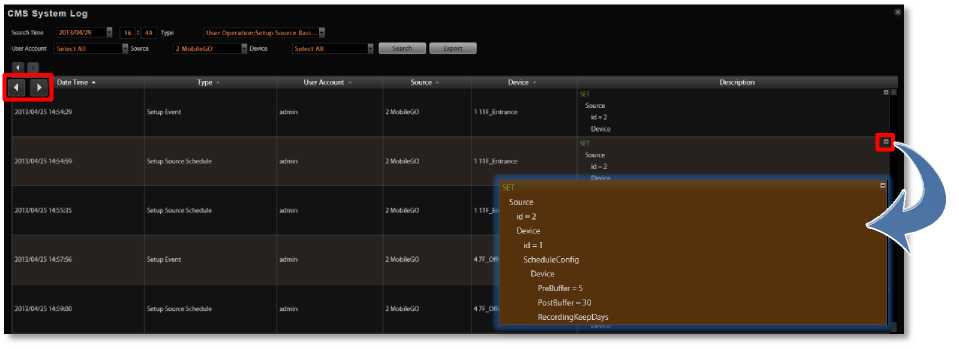
A log entry contains several kinds of information including Date Time, Type, User Account, Source, Device and Description. Check Type and Description fields to know what the user has done or what happened to the whole system. In Type field shows what major functions this behavior was involved in, in Description field narrates how the change was done (in green font color, uppercase) and the result (in white font color).
Take the case below for example, you can tell that the admin user set up an event rule on 2013/4/25 for #1 device(11F_Entrance) on #2 NVR(MobileGo) to trigger a response upon the motion detected by #1 device(11F_Entrance)’s motion region 1.
| Date Time | Type | User Account | Source | Device | Description | ||
| SET
source id = 2 Device |
s | ||||||
| 2013/04/25 14:54:29 | Setup Event | admin | 2MobileGO | 1 11F_Entrance | id = 1
EventHandleConfig EventHandle Event id = Motionl |
Note
If the pagination button appears to be disabled, that means no more records are found on CMS server. By default, the server will keep the logs for 30 days. If you wish to adjust the
period, please go to Setup page ^ System tab ^ Settings, in System Log Settin gs
section, key in the value in this field:
Keep System Log for (1-999 days) 30
Click “Export” button to export the log as .csv file. You can specify the Time Duration, NVR
Source, User Account and the involved Device of the logs, and click “Apply”.
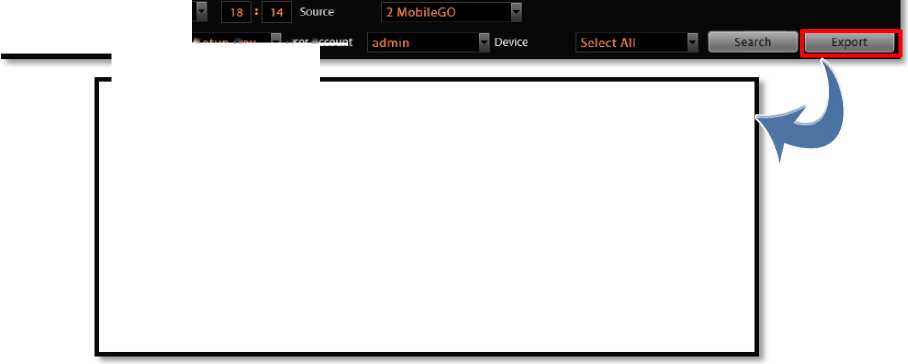
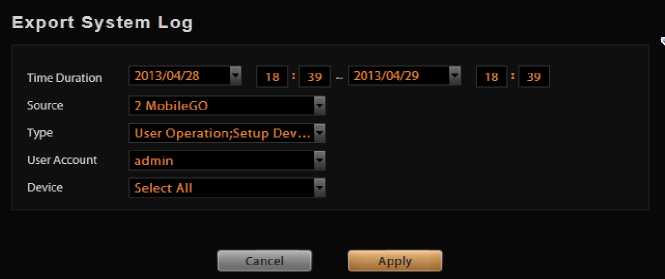
Source System Log
Search Time
2013/04/22
Type
User Operation;Setup Dev…1“1 user Account
As the CMS administrator owns the same privileges of an NVR administrator, it is able to acquire the NVR system log from CMS interface. Unlike CMS System Log, NVR Source System Log records an NVR user’s activities on NVR. Click , enter Source System Log, specify the NVR Source name and other criteria, CMS will start searching.
Source System Log
Search Time 2013/05/03 H 13 t 36 Source 1 ADR Branch
Type Select All n User Account I Select All n Device
Select All
on
Date Time
Type
User Account
Device
Description
After all NVRs and devices are added, you may start customizing the views for different users and purposes. This chapter will teach you how to add video source, arrange the channels and manage live view layouts.
In CMS system, a View refers to the layout where the live images of Cameras or Maps are placed in proper positions to suit the monitoring purpose. This is very similar to a camera group, which often consists of cameras in the same physical location. For example, a View named 11F Emap & Camera may contain the 11F floor plan and the cameras actually placed on 11F.
On CMS Live View, a saved View not only remembers (1) layout style, (2) which channel to display which camera, (3) but the fisheye view mode (for fisheye cameras only.
O View Toolbar
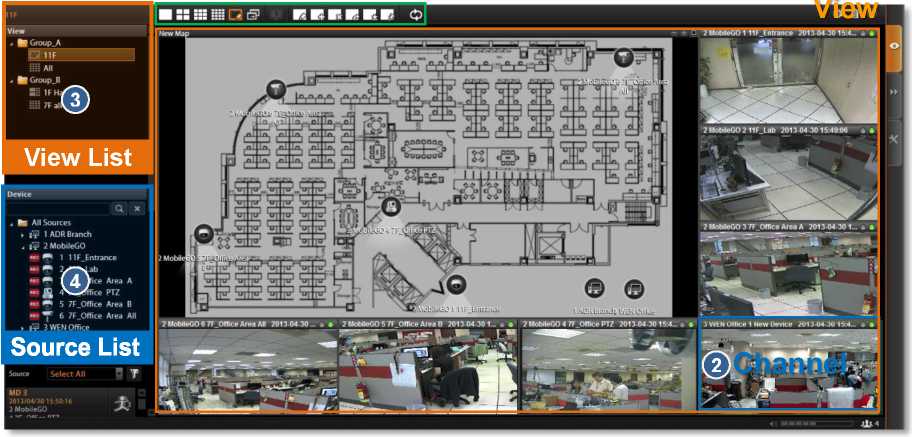
- View Toolbar: Provides 24 options for layout styles and the functions keys for editing a view.
- Channel: Each channel window may display a camera view or a map. In edit mode, you can adjust the channel size at will.
- View List: All the saved Views are shown here. On Live View, you can go to ^
View Manager to group and manage these views (refer to Manage the Views on page 66).
On View Tool Bar, click the Create View button | | input the View Name, add a New
Group for this View and decide whether this group is to be Public or Private, and then click
“Apply”.
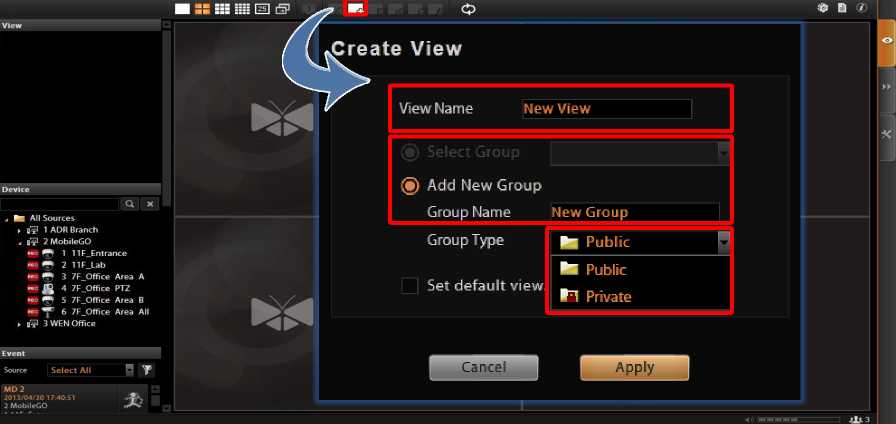
•The views under Private View Group La) are only available to the User who created them.
•The views under Public View Group □ are open to every User.

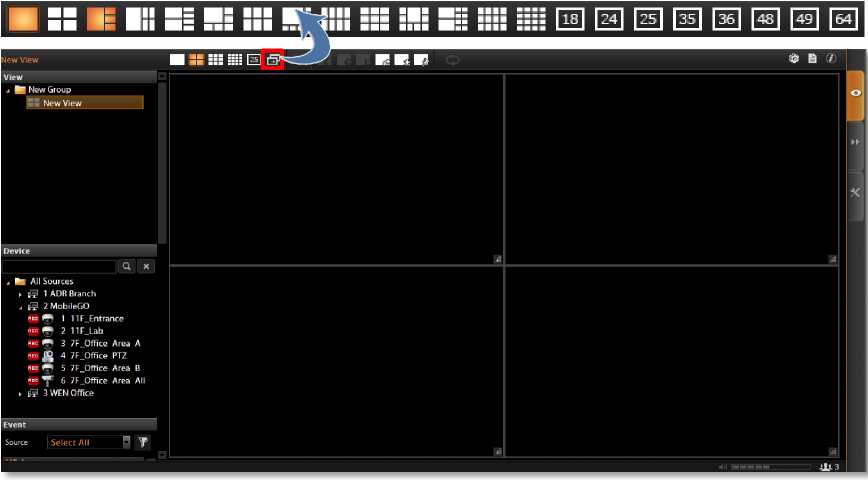
this view will turn into edit mode. In edit
layout that is perfect for your required channel number and ideal arrangement.
On View Toolbar, click the Edit View button mode, you may add a video source to a channel, and adjust the channel size.
On View Toolbar, click the Expand button to find all provided layout styles. Select a
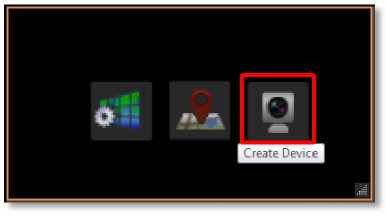

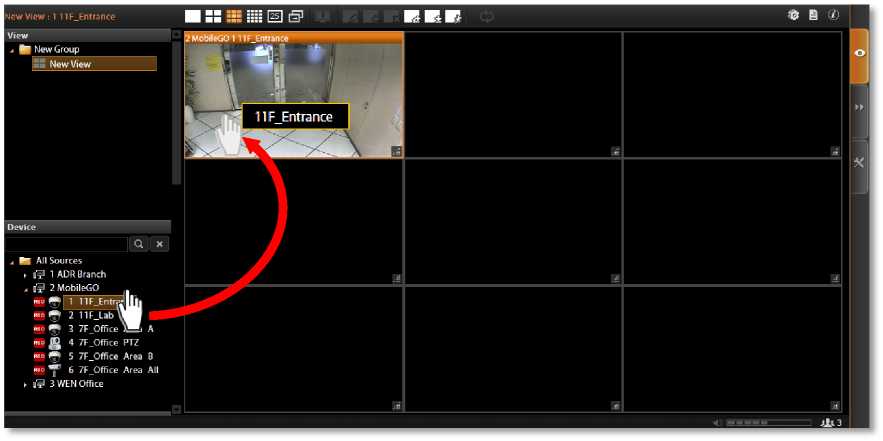
In edit mode, move the mouse over the channel
and click
to select a camera from the source
list. You may also directly pull a camera from the
Device panel to your desired channel.
•Remove the camera view: right-click on the channel and select “Remove”.
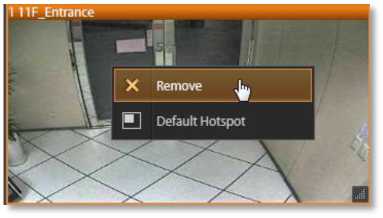
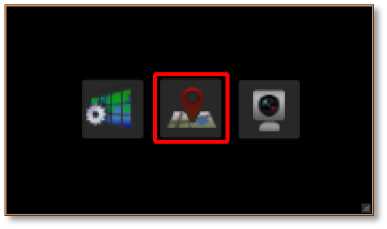
By adding a map, you put a picture on the channel, where you may place camera icons later to
make it an “e-Map.
In edit mode, move the mouse over the channel and click to upload a map. Please input the
Map Name, select the image location (file format must be JPG) and click “Apply”.
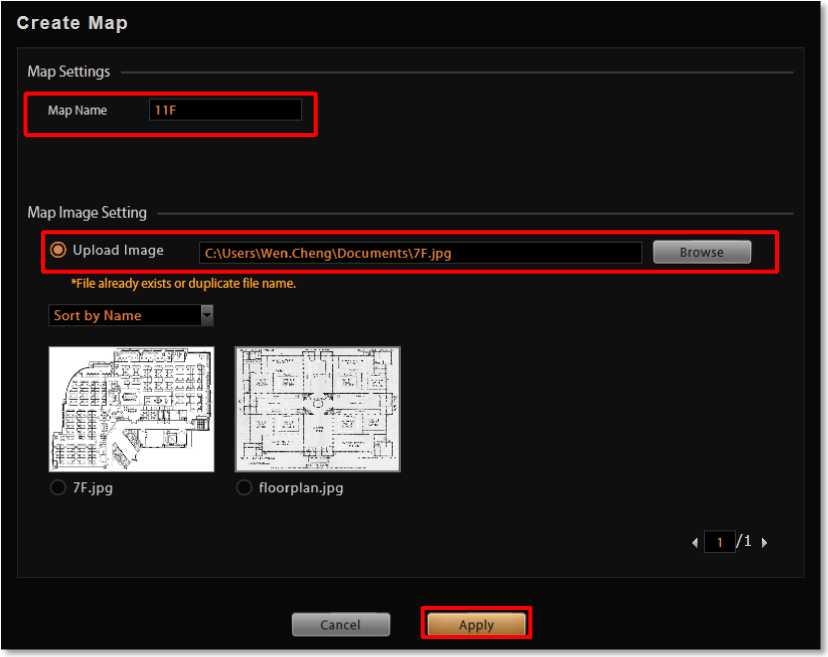
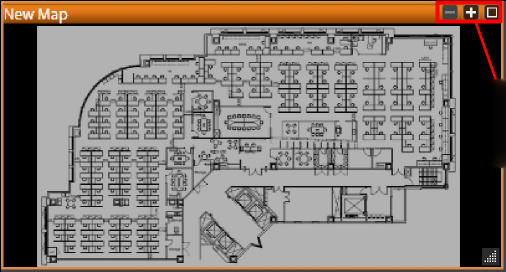
I
0% 10% 20% 30% 40%
50% 60% 70% 80% 90%
•Map size:
To change the map brightness, right-click on the map, select “Map Mask” and the brightness percentage level.
By default, the map will be displayed in its original size. Use the button s on upper right to adjust the map size.
TO Enlarge to fill channel height
i ] Original image size
a Zoom in
la Zoom out
The map title will be shown on channel title bar. In edit mode, right-click on a map channel and
select “Edit Map Information”
Right-click on the map and select “Remove”.
All the uploaded images are managed under Map Image Manager. On Live View screen, you may go to ^ Map Image Manager to view, upload or delete the maps.
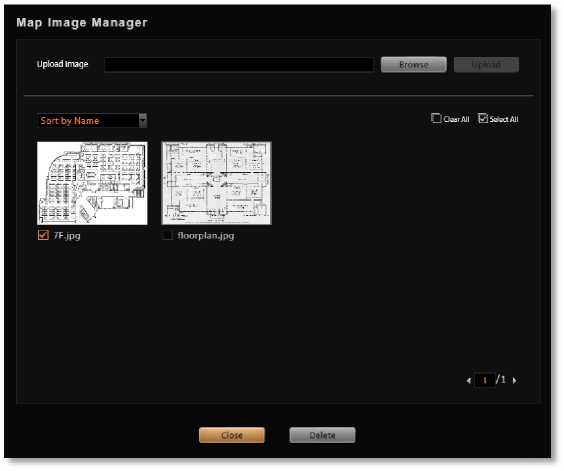
Step 6: Add Devices to the Map
Pull a device from Device List to the map.
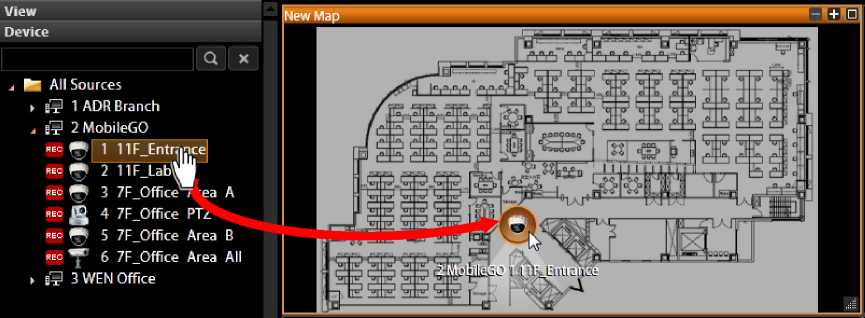
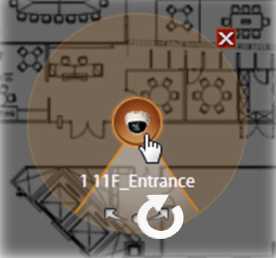
•To remove this device from map:
Click E3
•To move this device:
Left-click on the device icon and drag.
•To change the pointed direction:
Mouse over the viewing angle area, left-click on the clockwise arrow to turn the direction.
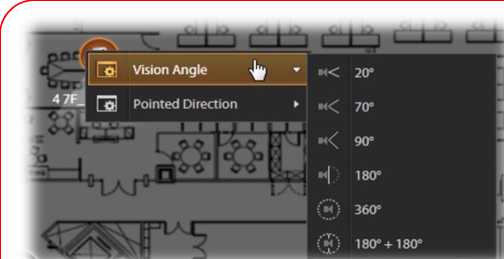
![]()
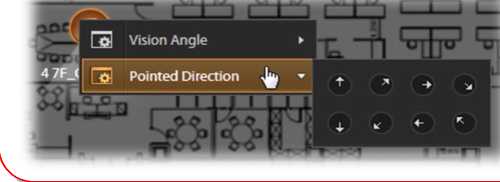
![]()

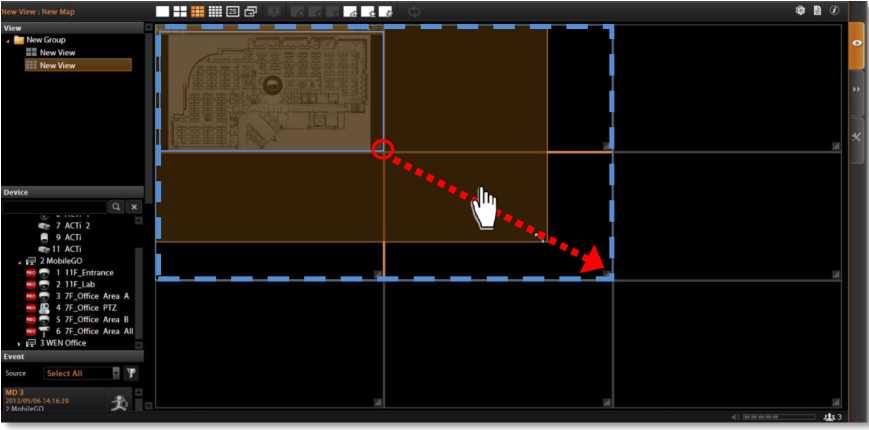
![]()
•To adjust precise pointed direction: Right-click on the device icon, select “Pointed Direction”.
•To adjust device’s viewing angle:
Right-click on the device icon, select
“Vision Angle”.
If this is a device of an NVR3 server (including GNR-3000 server, INR-410 server or INR-420
server) and its stream mode is set to DUAL or multi-streaming, you can choose a desired
stream from View Toolbar. This choice of stream will be remembered by this View.
Click S
on right lower corner of the channel window, drag and then release.
•Switch channel windows:
Step 7: Adjust the Channel Size & Layout
•Adjust the channel size:
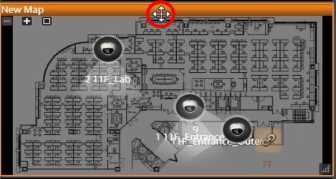 Click on a channel title until the cross arrow appears, hold it to drag this device or map to your desired channel.
Click on a channel title until the cross arrow appears, hold it to drag this device or map to your desired channel.
Click | J on View Toolbar to save it.
To set a View as default, select it in the View List panel and then ch on View Tool
Bar. By next time you log in, you will directly enter this View.
Step 10: Set Default Hotspot Channel (Optional)
By system default, the global hotspot channel will always be the top left one. You can set any
other channel on your live view screen to be the default hotspot channel. Right-click on the channel and select “Default Hotspot Bar to save it.
!■ I Default Hotspot
, then click
on View Tool
Step 11: Set Fisheye Camera Mode
Define a view for a fisheye camera channel by selecting its mode and using ePTZ control.
Please note that the maximum number of fisheye channels on the same View is 16.
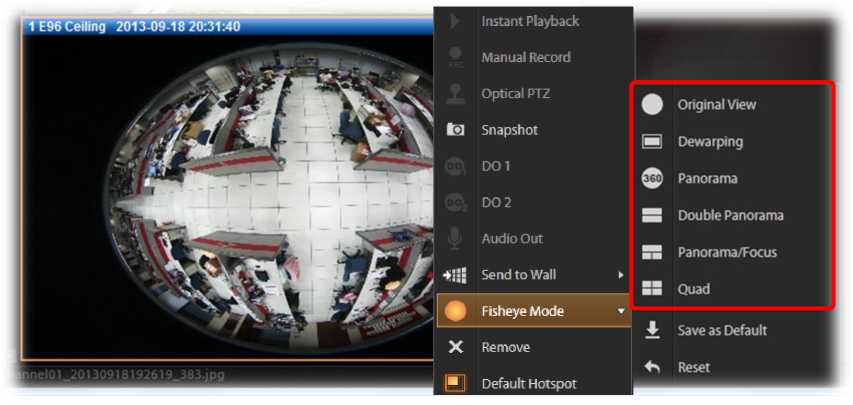
one mode.
2. After the fisheye mode is selected, click a region of interest.
•Use PTZ Panel controls to operate PTZ movements:
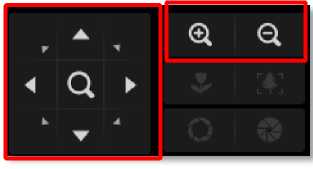
ePTZ Controls on PTZ Panel
8 directional buttons
Zoom in / Zoom out
•Click the mouse anywhere on the view to pan/tilt, scroll the mouse wheel to zoom
in/out.
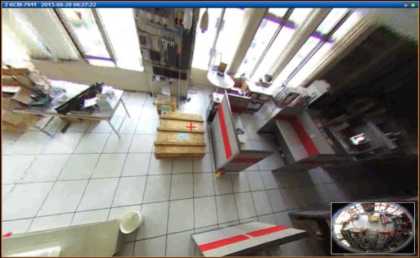
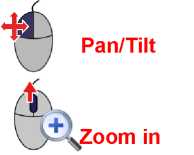

•To reset the ePTZ navigation area back to default viewing angle, right-click to bring up
channel menu, and then click “Reset”.
3. click on View Tool Bar to save the configuration.
Note
Once a channel is changed to any of the following fisheye modes: Dewarping, Panorama, Double Panorama, Panorama/Focus or Quad, the resolution of this live stream will become 1920×1080, while NVR still records the live stream at the resolution you set on Setup page.
Each View belongs to a specific View Group. With the group management, CMS makes it easy to deal with Views you created for multiple Users.
After you created and saved the Views on Live View screen, click ^ View Manager.
Click on the arrow icon in front of a group folder to reveal its Views.
(21 By selecting a View, you may directly modify its name in Name field.
(31 You may change a group’s Group Type. Upon the change, for example, by changing a
group from “Private” to ”Public”, all the views belonging to it will be open to every User.
[4] Click this icon to add a new group. |__O_
1 New Group Public
(5j Click this icon to delete a selected group.
[61 Click this icon to copy a selected group to another group.
(7J Click this icon to move a selected group to another group.
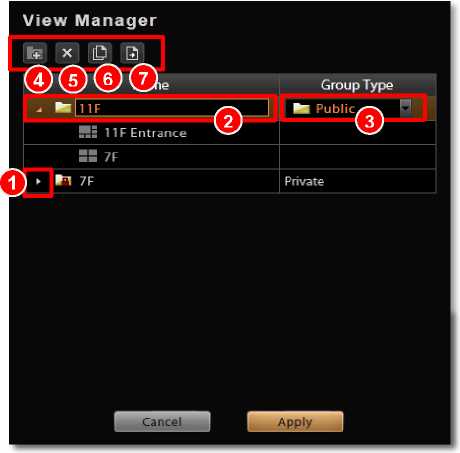
By creating a link button on a map view, you can directly be linked to another view. On the picture below shows how to create a link button to 7F View on 11F map.
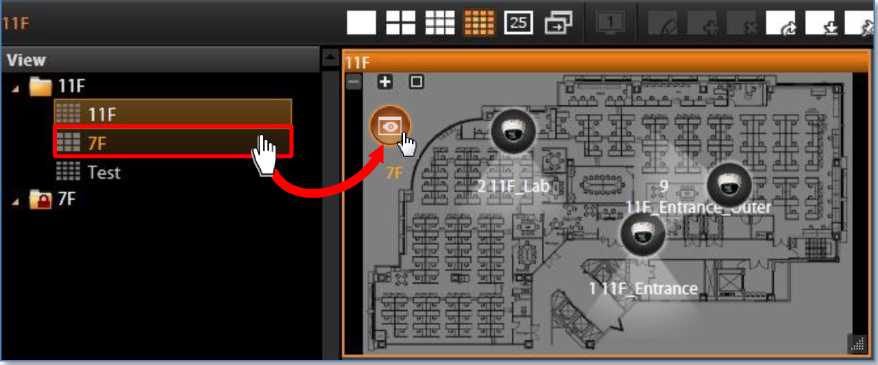
- Select a map View, on which you will place a link button to another view.
- Click on View Tool Bar to enter edit mode.
- From View List, drag the target View to current View, a link button will appear.
- Click on View Tool Bar to save it.
You may have the saved Views patrol in turns. In this way, the views in different area in your
site may cycle through themselves for you automatically.
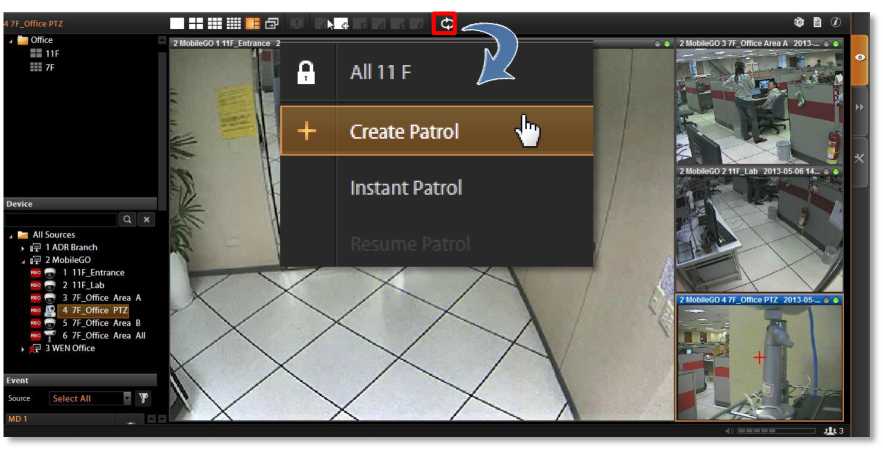
On View Tool Bar, click then Create Patrol.
- Input the Patrol Name.
- Select the Patrol Type to be open to all Users or to the creator only.
- Define the Global Dwell Time between the views. If you want to set different dwell time length for individual Views, do not check this option, and configure them separately in below table.
- Choose the Views to display in patrol. If you select the All Sources group, you will also need to select “Source Layout Style” for it.
- Click “Apply” to save the settings.
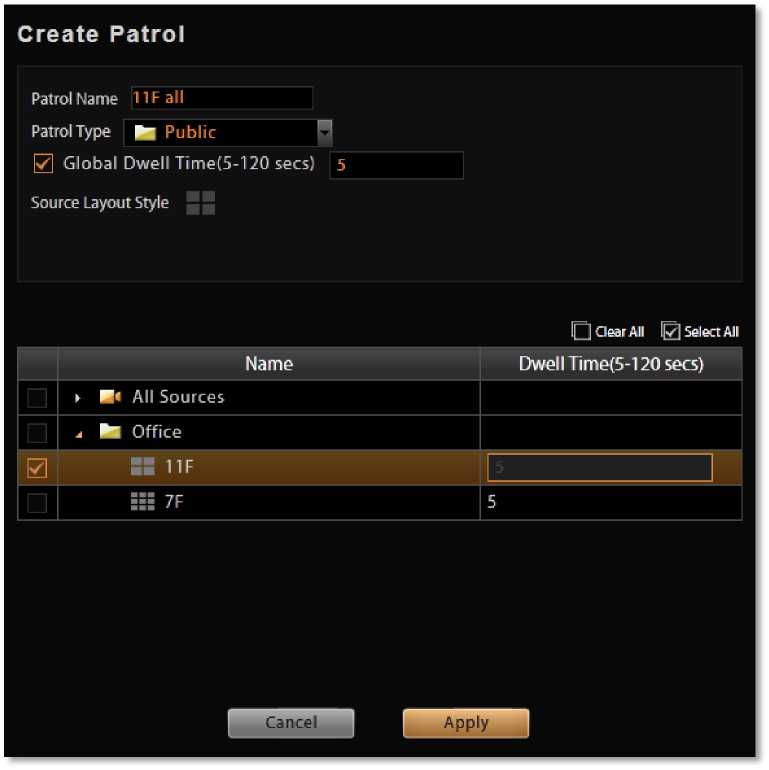
The saved patrols will be shown on the patrol list after you click on View Tool Bar, you may
6.
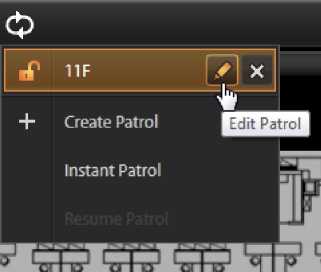 delete and edit a saved patrol or select it to start patrolling.
delete and edit a saved patrol or select it to start patrolling.
Tips to Enhance Live View Performance
Live view for multiple channels requires sufficient computing power to run the performance.
In certain extreme cases, like when viewing several megapixel H.264 video streams at the same time, client computer will be overloaded and hence affect browser’s performance. This is a common limitation imposed upon all Windows based video management programs and web browser.
To enhance live view performance, below are several tips you may try:
- Use another browser client to share these high-resolution channels. Given that there are 32 megapixel channels to be monitored, you may have Layout 1 to display channel 1~16, set Layout 2 to display channel 17~32, then open one browser client to show Layout 1 and the second browser on an extended monitor to show Layout 2.
- Have CMS automatically lower the frame rate of live streams when system loading is high. Go to Setup page ^ System tab^ Settings ^ Display Performance Setting and enable this function. Basically, this setting will lower frame rate when the CPU usage is above certain percentage. You may also enable “Lower the frame rate when current layout is above_”, in this way, when the layout is displaying over certain number of channels, the frame rate of all live streams will be declined. By default, this setting will be applied to the live display of all connected web clients and Workstation clients.
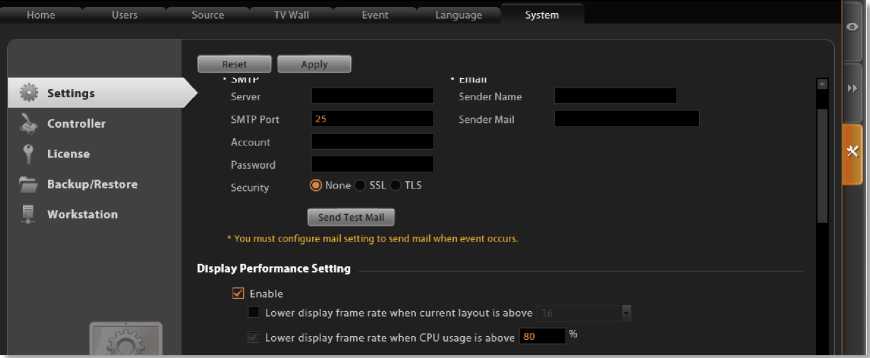
A Workstation client computer can have its own specific display configuration without being affected by CMS universal setting. Log in as CMS2 Workstation client, go to Setup page ^ System tab^ Workstation and configure the Display Performance Setting.

Let Windows Automatically Start up CMS Live View
You may have the CMS client application automatically run and open the live view after Windows starts. In this way, you may save steps and time before you eventually see the desired live view screen. Additionally, whenever a power breakdown takes place, the live view may recover as soon as your computer resumes.
If more than one users would log in to this computer, this tip might not be suitable due to account security issues.
- On CMS server, set a Default View for your account. For detailed procedures, please refer to this section in this manual: Customize Views on page 59.
- Set Auto-login for your Workstation client or web browser client. For detailed procedures, please refer to this section in this manual: C. Remember Account/Password on page 28.
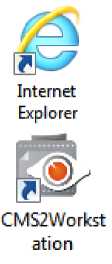 If you are using a browser client, open the browser, and set the CMS server IP as default homepage.
If you are using a browser client, open the browser, and set the CMS server IP as default homepage.- Set your browser or Workstation application to start right after Windows has started. Click Windows Start ^ Programs ^ Startup to open the Startup folder, and drag the application shortcut into it. In your case, you will have to drag the Internet Explorer shortcut or CMS2Workstation shortcut into the Startup folder.
- The next time you start Windows, CMS live view will be running automatically, and you may start monitoring the system in no time.
CMS server supports multiple languages for user interface display. There are already several translated language files in the server system. Each language is open to customization based on your own needs. This section will describe how to choose or customize language strings for your site.
You may decide which languages to be selectable on Login screen. The chosen languages will appear on the “Language” dropdown list.
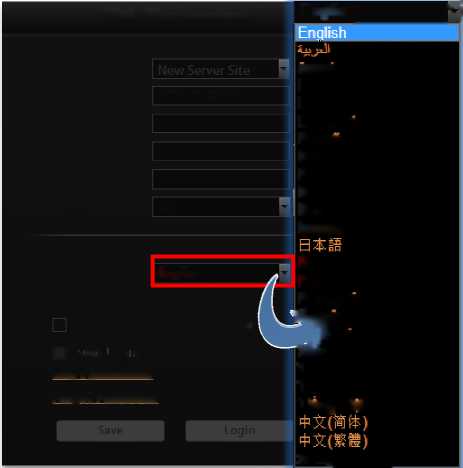
Live
Language
English
cesky
Dansk
Deutsch
EAAqviKa
Espanol
Suomen kieli
Français
Magyar
Bahasa Indonesia
Italiano
Nederlands Polski Portugues tfi^pnâ
Anil a3blK 5%nska Tna Türkçe Tieng Vret nnin
English Q
CMS Workstation
Forgot Password?
Server Name
Server IP
Server Port
Account
Password
Initial Page
Remember Account/Password
Auto Login
Don’t Remember
172.16.26.91
1018
Go to Setup page ^Language tab, click “Active Languages”. On popup window, check the languages you need, and click “Apply”. By default, all languages are selected. As English and
Traditional Chinese are the default system language, they are not removable from this list.
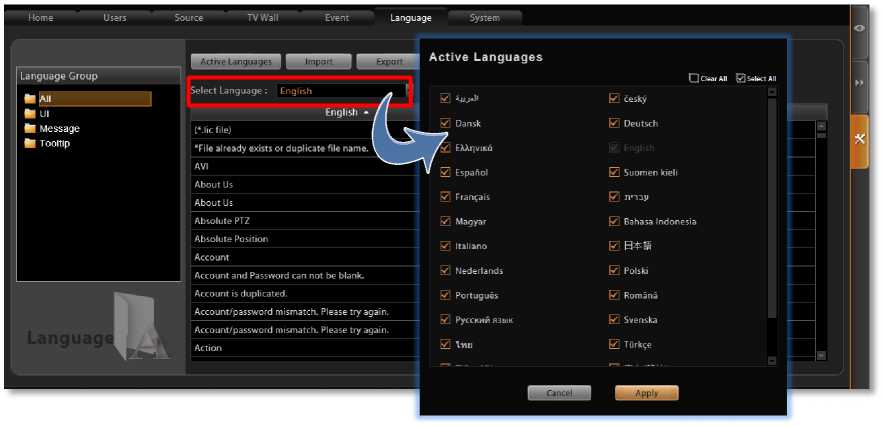
Each language file contains four editable string tables. Each table displays the default wordings in English and the translation in target language.
To view the string table:
“Language Group” list on the left column.
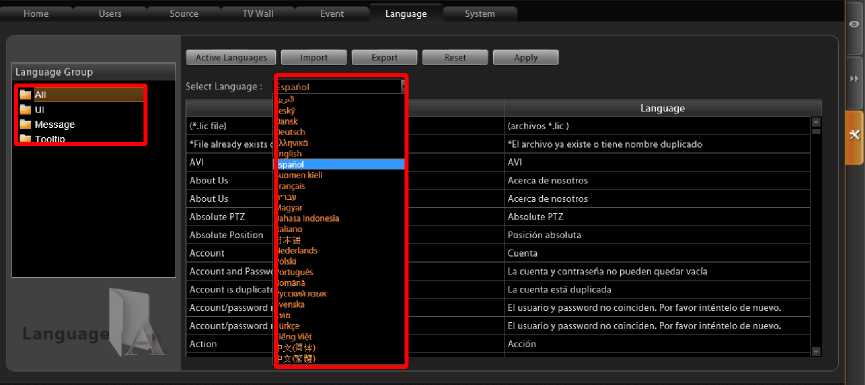
language “English” appears on the left for reference. Click in any field on right column to
customize your desired wordings, and click “Apply” to overwrite the current.
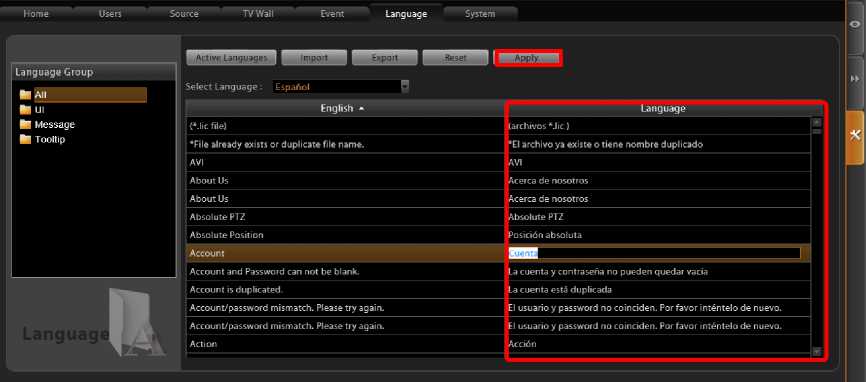
The new string will be applied by next time you log in. If you log in as a CMS2 Workstation client, please pres button on Login page to synchronize with the latest modified
language file, then log in to the system.
CMS Workstation
| Server Name | |
| Server IP | 172.16.26.91 |
| Server Port | 1018 |
| Account
Password Initial Page |
Live |
Language
English
Remember Account/Password
Don’t Remember
Forgot Password?
Export / Import Language String File
You may also click “Export” to export the language file as .xml format to edit in Notepad, or
“Import” to import a language file to use in the system.
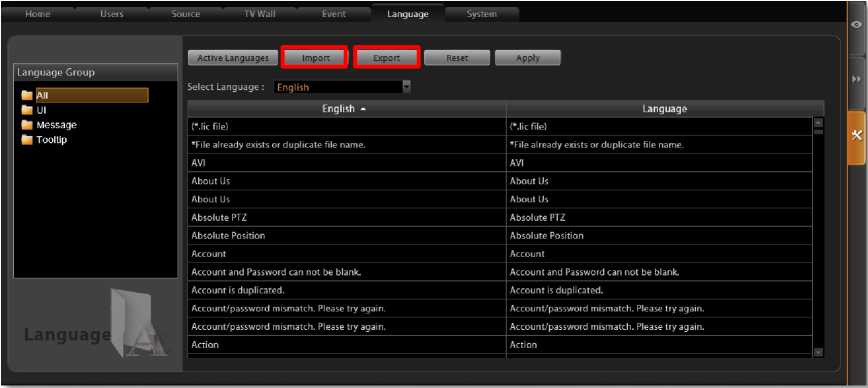
In general, it is suggested that you always save a modified language table with a different file name in a location other than default system language folder on server computer C:\Program Files\ACTi Corporation\CMS2\Language, then import it to use. In this way, you can avoid overwriting the original language file.
You can change the user interface style by arranging the main screen and Panel/Device List on the right or left. Go to Setup page^System tab^Settings, scroll down to the User Interface Style section, select the setting style then click “Apply”. The change will be applied upon your next login.
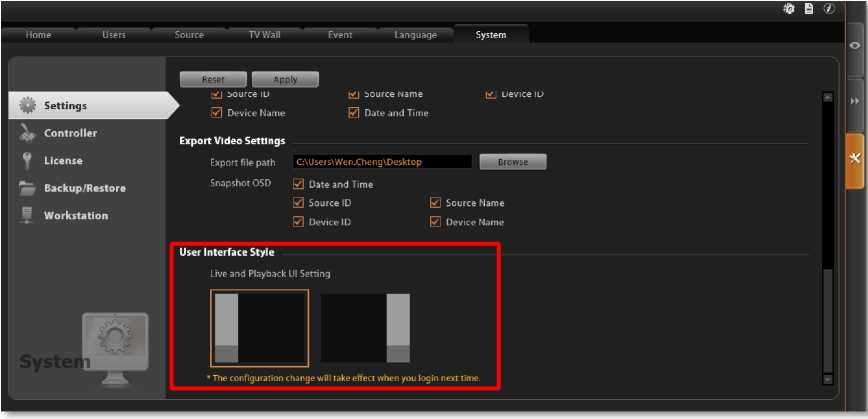
Video & Snapshot Export Configurations
By default, the snapshots taken by Users on Live View and all exported video files are saved to the current client’s Desktop. You may configure the destination by selecting another available file location on your client’s computer. Go to Setup page^System tab^Settings, in Export Video Settings section, click “Browse” to choose the file path.
You may also define what information is printed on each snapshot by checking the items: Date and time, Source ID, Device ID, Source Name and Device Name.
These configurations will take place after you click “Apply”.
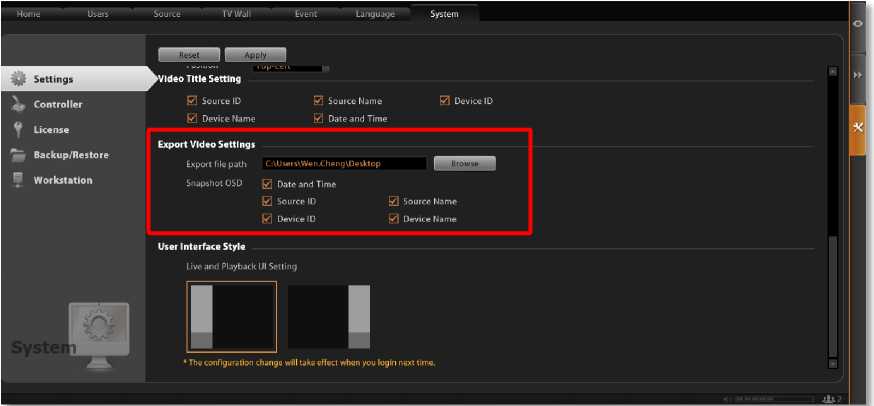
In CMS, other than user interface PTZ panel and mouse operation, you may also control the PTZ movements by physical controllers. CMS supports two types of controllers, which both feature in a joystick with twelve buttons for users to assign specific actions.
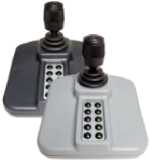
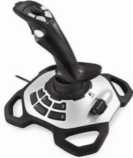
Model: IP Desktop
Manufacturer: CH Products
Manufacturer: Logitech
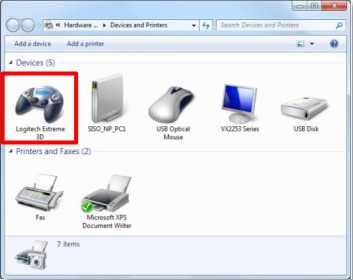
- Log out from CMS client interface.
- Connect the controller device to your computer. To make sure the device is installed properly, open Windows Start menu and enter Devices and Printers to check the status.
- Log in to CMS server, go to Setup page ^System tab, enter “Controller” section and select your product.
- You may assign specific commands from dropdown list to buttons 1~12 of the controller. When setting is done, click
“Apply”. The modification you did on one controller model will be applied to the other
joystick model as well.
5. To validate its function, go to Live View page and focus on a PTZ device channel to
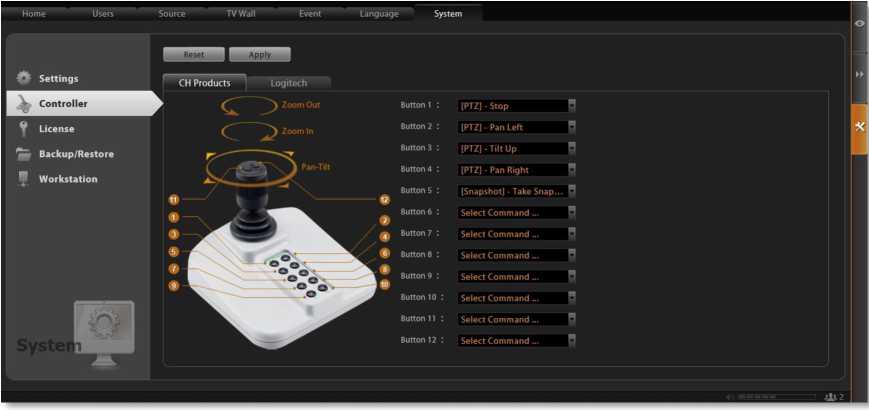
operate the supported PTZ operations.
In certain cases, un-installation of CMS system is necessary, for example, (1) you want to terminate CMS server and clear all the evidence due to privacy and security reasons, (2) you need to reinstall the system due to an unsuccessful installation.
Before starting un-installation, please back up important data (please refer to Back up System Data on page 79) first and prepare the CMS server install shield application. This chapter will describe un-installation process.
Step 1: Remove CMS Server Program
1. Go to Windows Control Paneli Programs and Features (in Windows Vista /Windows
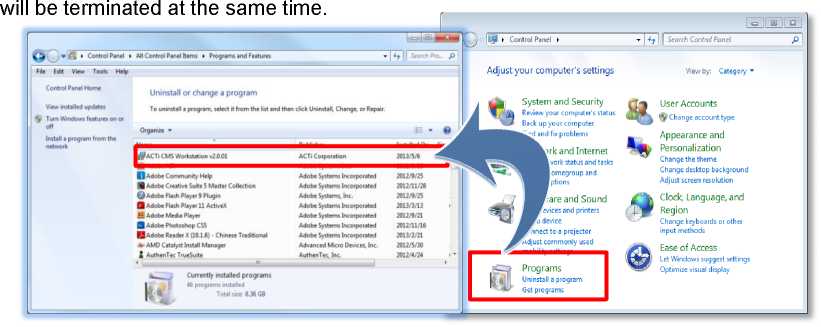
7/Windows 2008) to remove it. When you un-install CMS server program, the web client
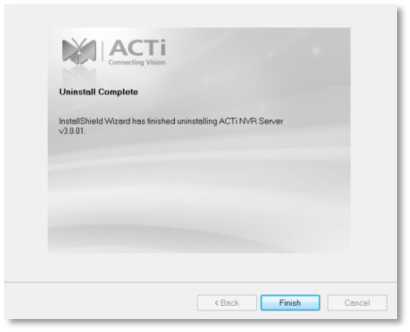 2. After you choose to uninstall “ACTi CMS Server” program, the uninstallshield will execute and notify you when it is completed.
2. After you choose to uninstall “ACTi CMS Server” program, the uninstallshield will execute and notify you when it is completed.
Step 2: Remove CMS Server Program Folder (Optional)
If you are performing a complete un-installation without leaving any CMS server related data on the current computer, you may consider deleting this folder.
After un-installation, the CMS system folder will remain under ACTi product folder ACTi Corporation on your hard drive, the system configuration data here will not be removed until
you delete them manually. By default, the path of CMS system folder is C:\Program Files\ACTi Corporation.
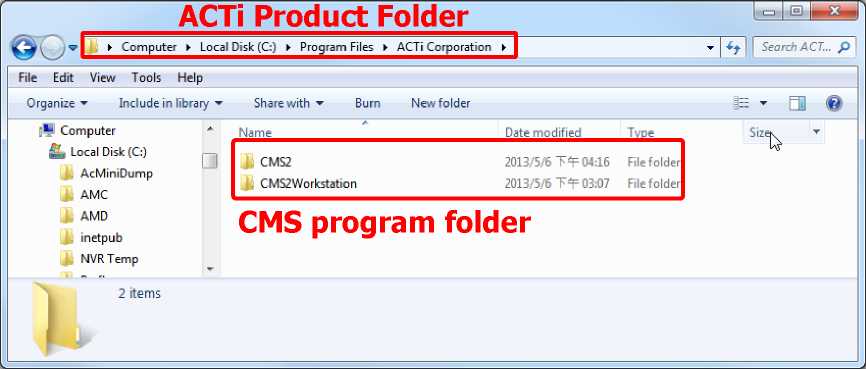
However, keeping this folder is convenient for a un-installation followed by an instant re-installation, for the previous system settings can directly be applied to the new server.
Making regular system backups is always recommended in case of unexpected disasters or accidents that may damage CMS server. Other than this, you may need to perform an on-demand backing up to (1) migrate the whole CMS server data to another computer, or (2) re-install the CMS server on current computer. There are several types of data on CMS server essential to your surveillance system please consider your purpose and follow the below instructions to create their backups.
CMS server can create a backup file of the whole system settings within one click. The settings being backed up include the following properties you set for system: (1) Users (2) Imported NVR Source & Device properties (3) Event Rules (4) System ^Settings / User Interface Style / Joystick, and (7) the saved Views in Live View page, and (8) TV Wall Server information and TV Wall Views.
Step 1: Back up CMS System Settings
1. Go to Setup page ^System tab^ Backup / Restore
saved as Backup_YYYYMMDD.xml file. Then click “Backup” to export the file.
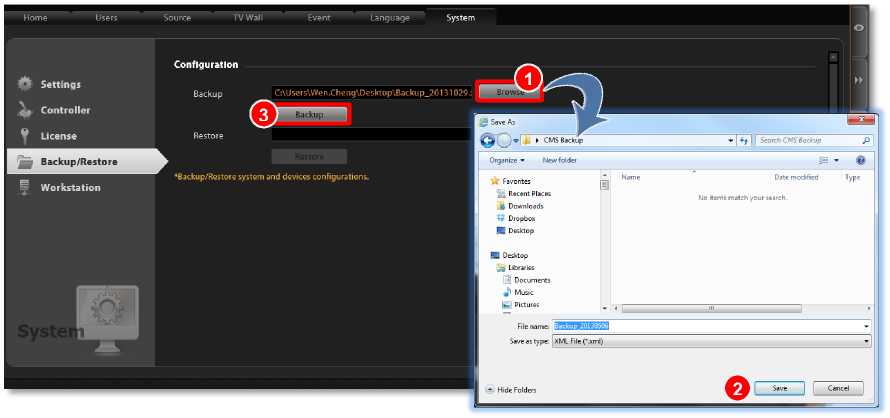
Important Notice
The license data is not included in the system backup file. You have to preserve the license key information provided in email or printed card to you after the purchase takes place.
Step 2: Back up CMS System Log (Optional)
The system log records the operations Users perform during logging in to CMS server. You may export the system log of latest three days as *.csv file as backup. Please refer to the section in this manual: Export the Log on page 58 for instructions.
Step 3: Back up NVR Source Backup (Optional)
You may also back up individual NVR’s system on Setup page ^ System tab^Source tab. This backup file is the same with that made on the NVR interface, which contains the entire system settings of an NVR server and its customized Views.
On Source tab, select your desired NVR and enter its sub category Maintenance. Click
“Backup”, select a file destination path and click “Apply”.
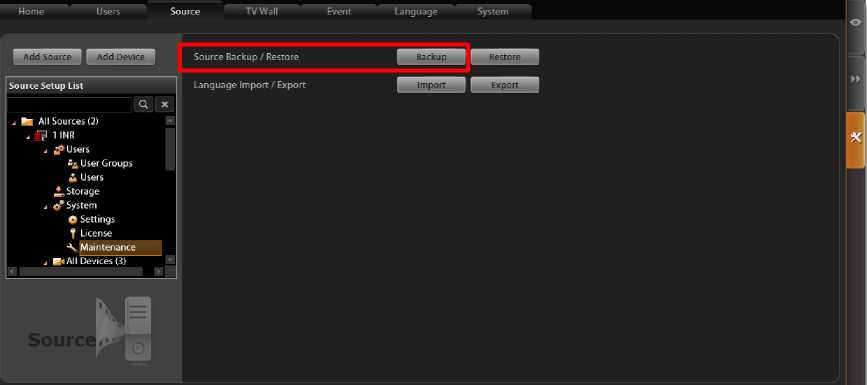
Before starting restoring the system, make sure you have done the following:
If you have activated the CMS licenses then done un-installation previously, please contact ACTi Customer Help Desk http://www.acti.com/CHD to clear the original registration data in ACTi license database, prepare the license key information for online activation or the activation file(.lic) for offline activation, and follow the instructions How to Activate the Licenses on page 21 to activate your license. The license should be activated before settings are restored so that the licensed channels are ready for recovery.
To start,
- Go to Setup page ^System tab^ Backup / Restore
- In Restore section, Click “Browse” to select the backup file, and then click “Restore” to start restoring the settings.
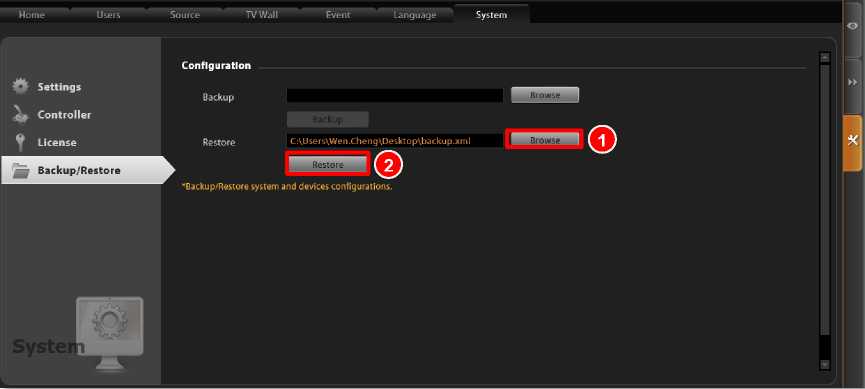
- The restoring process requires logging out of CMS server. After restoring is done, you may log in using your previous user account properties.
To assist the CMS administrator in monitoring the server status and basic trouble-shooting, the CMS2 Administrator Tool is installed along with CMS server program on the server computer. This tool will start running as the server computer starts up, and resides in the system tray. You may double-click the icon to open this tool.
![]()
![]()
![]()
![]()

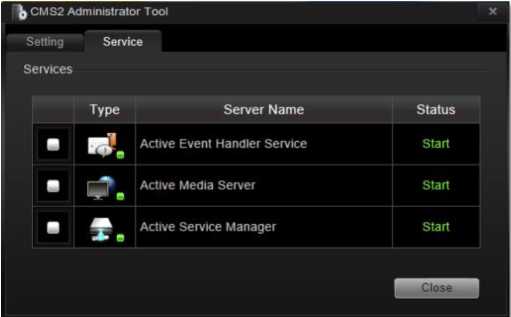
You may observe the CMS services status on Service tab.
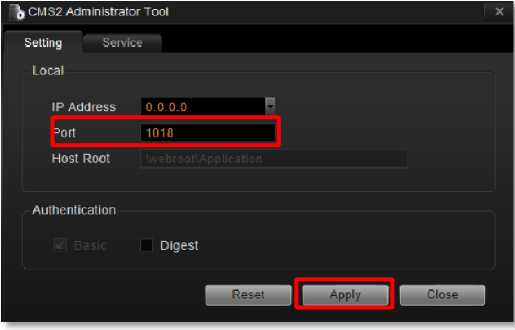
On Settings tab, input a new port and then click “Apply”
You may enable the Digest authentication other than the basic way. With this method, when logging in to CMS server, User’s credentials are encrypted using MD5 algorithm. In this way, there is more secure protection to prevent from unauthorized access.
Please also note that, with Digest authentication method enabled, a mobile client user or a
domain user will be blocked from CMS system.
